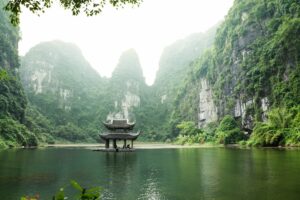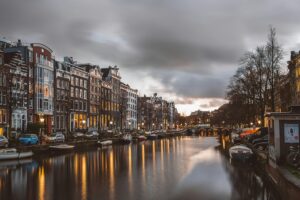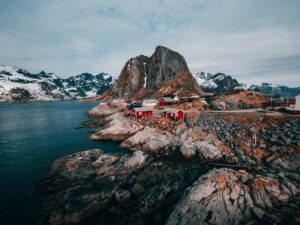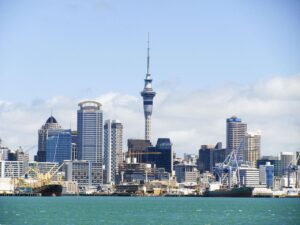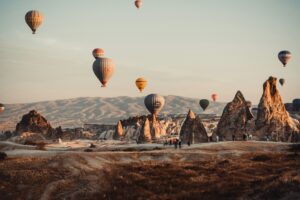California, the Golden State, stretches along the Pacific Coast with an intoxicating blend of natural wonders, cultural diversity, and iconic landmarks that have captivated travelers for generations. From the fog-kissed streets of San Francisco to the sun-drenched beaches of San Diego, from the towering sequoias of the Sierra Nevada to the celebrity-studded boulevards of Los Angeles, California offers an embarrassment of riches for every type of traveler. Whether you’re a first-time visitor planning your dream vacation or a seasoned explorer seeking hidden gems in California, this comprehensive guide will help you navigate the top 10 places to visit in California and transform your trip into an unforgettable adventure.
Spanning nearly 900 miles from north to south and encompassing everything from desert landscapes to alpine forests, California is more than just a state; it’s a collection of distinct worlds, each with its own personality, climate, and attractions. The sheer diversity of experiences available makes California one of the most visited destinations in the United States, attracting over 280 million visitors annually. This guide will not only highlight the top 10 places to go in California but also provide insider California travel tips, reveal lesser-known treasures, and answer all your burning questions about what to do in California.
TL;DR – Quick Links to the Top 10 Places to Visit in California
- San Francisco (Google Maps)
- Yosemite Valley, Yosemite National Park (Google Maps)
- Los Angeles, Hollywood Sign (Google Maps)
- Balboa Park, San Diego (Google Maps)
- Emerald Bay State Park, Lake Tahoe (Google Maps)
- McWay Falls, Big Sur (Google Maps)
- Downtown Napa, Napa Valley (Google Maps)
- Prairie Creek Redwoods State Park (Google Maps)
- Badwater Basin, Death Valley National Park (Google Maps)
- Stearns Wharf, Santa Barbara (Google Maps)
1. San Francisco: The City by the Bay
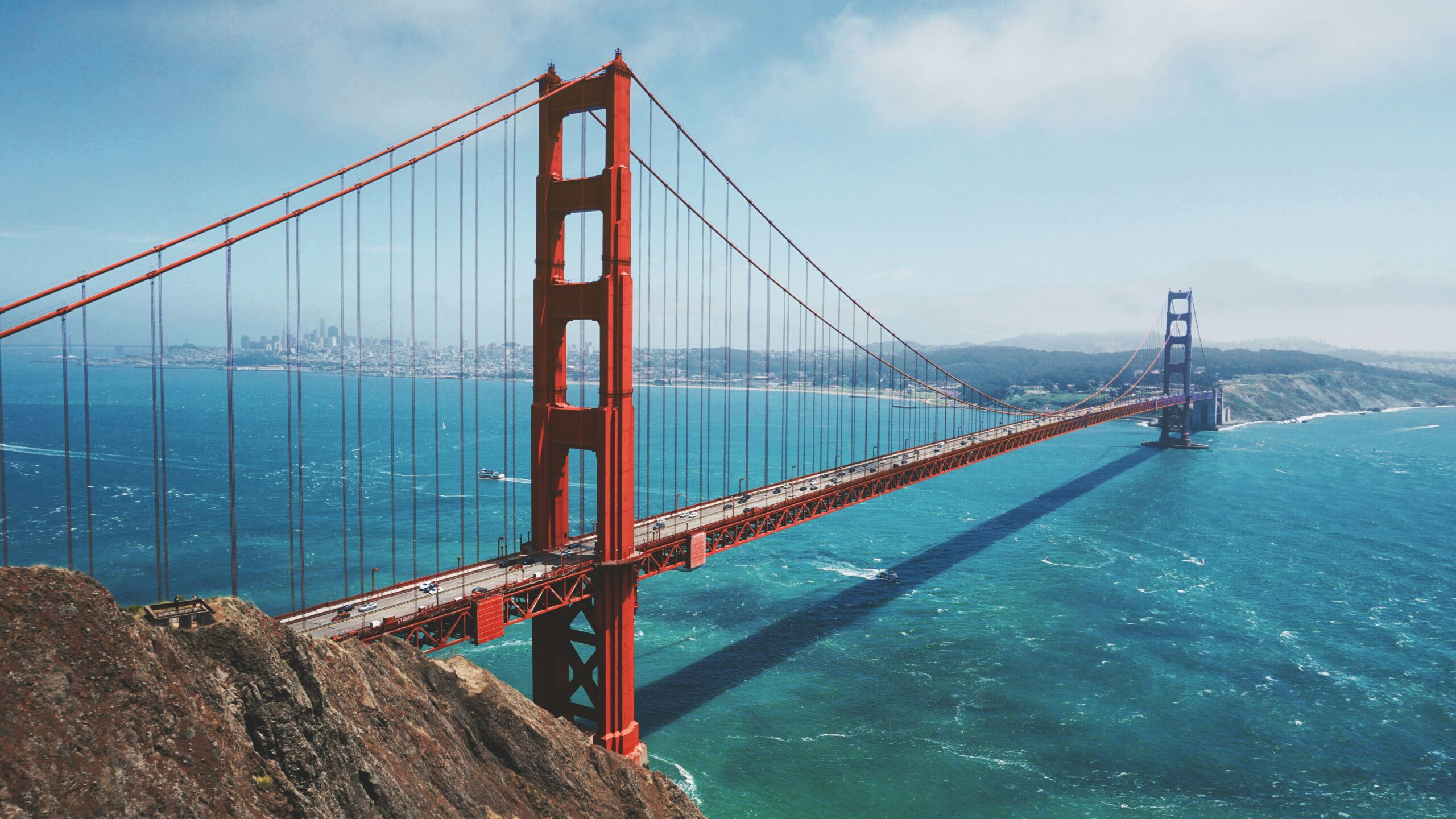
San Francisco stands as one of the most photographed cities in the world, and for good reason. This compact city of just 49 square miles packs in more personality, culture, and stunning views than cities ten times its size. When people think about the top 10 places in California, San Francisco invariably tops the list, and after you experience its unique charm, you’ll understand why.
The Golden Gate Bridge and Its Majestic Surroundings
No visit to San Francisco is complete without witnessing the Golden Gate Bridge in all its Art Deco glory. This internationally recognized symbol of the city stretches 1.7 miles across the Golden Gate Strait, connecting San Francisco to Marin County. The bridge’s distinctive International Orange color was specifically chosen to make it visible through the thick fog that frequently blankets the bay. For the best views, visit Battery Spencer on the Marin side for a spectacular vantage point, or walk or bike across the bridge itself, an experience that offers constantly changing perspectives of the city, Alcatraz Island, and the Pacific Ocean.
Adjacent to the bridge, the Presidio offers 1,500 acres of parkland with hiking trails, historic military buildings, and stunning overlooks. Don’t miss Crissy Field, a restored tidal marsh and beach area perfect for picnics, kite flying, and watching windsurfers brave the chilly waters. The nearby Palace of Fine Arts, with its Greco-Roman rotunda reflected in a tranquil lagoon, provides one of the city’s most romantic settings.
Alcatraz Island: America’s Most Notorious Prison
A visit to Alcatraz Island ranks among the most compelling experiences in San Francisco. This former maximum-security federal penitentiary housed some of America’s most infamous criminals, including Al Capone, George “Machine Gun” Kelly, and Robert Stroud, the “Birdman of Alcatraz.” The ferry ride to the island offers breathtaking views of the city skyline and the Golden Gate Bridge, but the real magic happens once you step onto “The Rock.”
The audio tour, narrated by former inmates and correctional officers, brings the prison’s history to life in a way that’s both chilling and fascinating. You’ll walk through the cellblocks, stand in a tiny cell, and hear firsthand accounts of the famous escape attempts. The gardens maintained by prisoners also provide a surprising contrast to the harsh prison environment. Tickets sell out weeks in advance during peak season, so book early to avoid disappointment.
Fisherman’s Wharf and Pier 39
Fisherman’s Wharf represents San Francisco’s playful, tourist-friendly side. While some locals dismiss it as too commercial, it remains one of the city’s most vibrant areas, especially Pier 39, with its resident colony of boisterous sea lions. These California sea lions first arrived in January 1990, and their numbers can swell to over 900 during the winter months. Watching them bark, play, and lounge in the sun never gets old.
The wharf area also features the historic Hyde Street Pier with its collection of vintage vessels, the fascinating Musée Mécanique with its antique arcade games, and countless seafood restaurants serving fresh Dungeness crab. For an authentic experience, grab a steaming bowl of clam chowder in a sourdough bread bowl from Boudin Bakery, a San Francisco institution since 1849.
Cable Cars and Victorian Architecture
San Francisco’s cable cars are more than just transportation; they’re moving historic landmarks and one of the city’s most delightful experiences. The three remaining cable car lines offer scenic routes through the city’s famous hills. The Powell-Hyde line is particularly spectacular, offering views of Alcatraz, the bay, and Russian Hill before descending to the waterfront.
As you ride the cable cars, you’ll pass through neighborhoods showcasing San Francisco’s famous Victorian architecture. The “Painted Ladies” of Alamo Square are the most photographed, but don’t overlook the stunning Victorians in the Haight-Ashbury, Pacific Heights, and Mission districts. Each neighborhood has its own distinct character, from the bohemian vibe of the Haight to the upscale elegance of Pacific Heights.
Golden Gate Park: An Urban Oasis
Larger than New York’s Central Park, Golden Gate Park stretches three miles from the Haight-Ashbury neighborhood to Ocean Beach. This magnificent urban park contains numerous attractions, including the California Academy of Sciences with its living roof and four-story rainforest dome, the de Young Museum with its observation tower offering 360-degree city views, and the tranquil Japanese Tea Garden, the oldest public Japanese garden in the United States.
The park also features the Conservatory of Flowers, a Victorian greenhouse filled with rare and exotic plants, and the stunning San Francisco Botanical Garden with over 8,000 plant varieties from around the world. On weekends, you might encounter drum circles at Hippie Hill, roller skaters at the skating rink, or paddleboaters on Stow Lake.
Exploring Diverse Neighborhoods
San Francisco’s true character emerges in its distinct neighborhoods. Chinatown, the oldest in North America, buzzes with authentic restaurants, herbal shops, and markets selling exotic produce. Walk through the Dragon’s Gate on Grant Avenue and explore the narrow alleyways like Waverly Place with its colorful balconies and historic temples.
The Mission District showcases vibrant Latino culture, incredible street art, and some of the city’s best food. The murals in Clarion Alley and Balmy Alley transform these streets into outdoor galleries. This is also where you’ll find the most authentic Mexican taquerias; La Taqueria and El Farolito are local favorites for their super burritos.
North Beach, the Italian neighborhood, charms visitors with its sidewalk cafés, gelato shops, and the historic City Lights Bookstore, a gathering place for Beat Generation writers. Climb the Filbert Steps through lush gardens to reach Coit Tower, which offers panoramic views and Depression-era murals inside.
What to Do in California: San Francisco Edition
Beyond the major attractions, San Francisco offers countless experiences that reveal the city’s quirky personality. Take a ferry to Sausalito or Tiburon for waterfront dining with views back to the city. Explore the sea caves at Lands End and walk the coastal trail past the ruins of the Sutro Baths. Visit during fleet week in October to see the Blue Angels perform aerial acrobatics over the bay.
For foodies, San Francisco is paradise. From Michelin-starred restaurants to hole-in-the-wall ethnic eateries, the culinary diversity here rivals any city in the world. The Ferry Building Marketplace showcases local and artisanal food vendors, while the Mission District offers everything from Vietnamese banh mi to Peruvian ceviche to San Francisco’s famous sourdough bread.
2. Yosemite National Park: Nature’s Cathedral
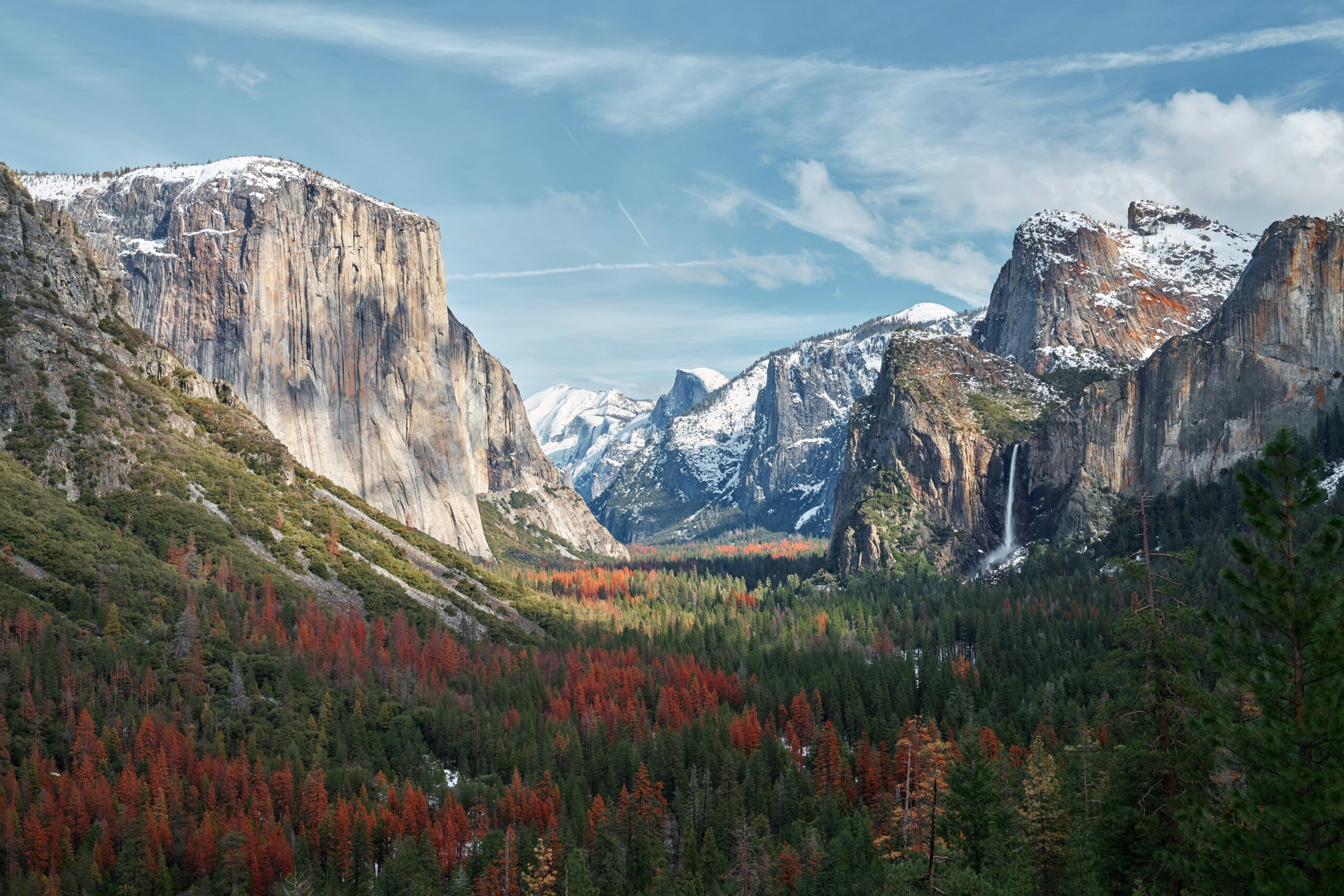
When considering what to do in California, Yosemite National Park stands as an absolute must-visit destination. This UNESCO World Heritage site attracts over four million visitors annually, all drawn by its staggering natural beauty. Yosemite Valley, carved by glaciers over millions of years, presents a landscape so dramatic it seems almost unreal, towering granite cliffs, thundering waterfalls, giant sequoias, and meadows carpeted with wildflowers.
Iconic Landmarks of Yosemite Valley
Half Dome, rising nearly 5,000 feet above the valley floor, serves as Yosemite’s most distinctive landmark. Its sheer granite face challenges climbers from around the world, while the more accessible cable route to the summit requires a permit (awarded by lottery) and a full day of strenuous hiking. Even if you don’t attempt the summit, the sight of Half Dome from various valley viewpoints never fails to inspire awe.
El Capitan, the world’s largest exposed granite monolith, rises 3,000 feet above the valley floor. Rock climbers consider conquering “El Cap” the ultimate achievement in big-wall climbing. Even non-climbers enjoy watching through binoculars or telescopes as tiny figures make their way up routes with names like “The Nose” and “The Dawn Wall.” The meadow at the base of El Capitan offers excellent viewing and photography opportunities, especially during sunset when the granite glows golden-pink.
Waterfalls: The Valley’s Liquid Silver
Yosemite boasts some of North America’s tallest waterfalls, and spring snowmelt creates spectacular displays. Yosemite Falls, North America’s tallest waterfall at 2,425 feet, consists of three sections: Upper Falls, Middle Cascades, and Lower Falls. The thunderous roar and mist from the falls can be felt from the valley floor, especially in May and June when the flow peaks.
Bridalveil Fall, one of the first waterfalls visible when entering the valley, drops 620 feet in a delicate cascade that often catches the wind, creating a bridal veil effect. The Ahwahneechee people, who originally inhabited Yosemite, called it Pohono, or “Spirit of the Puffing Wind.” A short walk from the parking area leads to the base, where the mist creates rainbows on sunny days.
Vernal Fall and Nevada Fall, accessed via the Mist Trail, offer more intimate waterfall experiences. The Mist Trail truly lives up to its name. Hikers climbing the granite steps beside Vernal Fall get thoroughly drenched in the spray, a refreshing experience on hot summer days. The round-trip hike to Nevada Fall covers about six miles and includes over 2,000 feet of elevation gain, but the spectacular views make every step worthwhile.
Giant Sequoias: The Mariposa Grove
The Mariposa Grove contains over 500 mature giant sequoias, including the Grizzly Giant, estimated to be around 1,800 years old. These massive trees, found only in California’s Sierra Nevada, are the largest living things on Earth by volume. Walking among these ancient giants provides a humbling perspective on time and nature’s power.
The grove’s most photographed tree, the California Tunnel Tree, had a tunnel carved through its base in 1895. While we now know such practices harm these ancient trees, it remains a popular photo opportunity and a reminder of changing attitudes toward conservation. The grove offers several trails of varying difficulty, from the easy Big Trees Loop to the more challenging Mariposa Grove Trail.
Glacier Point: The Ultimate Vista
Glacier Point, accessible via a winding mountain road from late spring through fall, offers arguably the best view in all of Yosemite. From this 7,214-foot overlook, you’ll see Half Dome, Yosemite Falls, Vernal Fall, Nevada Fall, and the High Sierra peaks stretching to the horizon. Sunset from Glacier Point ranks among the most spectacular shows nature provides the granite peaks glow pink and orange while the valley below gradually fills with purple shadows.
For the adventurous, hiking down from Glacier Point to the valley via the Four Mile Trail (actually 4.8 miles) provides an unforgettable experience. The trail descends 3,200 feet through varied terrain, offering constantly changing perspectives of the valley. Most hikers prefer going downhill; the uphill version ranks as one of the park’s most strenuous day hikes.
Tuolumne Meadows: The High Country
While Yosemite Valley captures most visitors’ attention, the high country around Tuolumne Meadows (accessible summer through early fall) offers a different but equally compelling experience. At 8,600 feet, this subalpine meadow stretches two miles long, decorated with wildflowers in July and August. The crystal-clear Tuolumne River meanders through the meadow, creating scenes of serene beauty.
From Tuolumne Meadows, numerous trails lead to alpine lakes, granite domes, and high peaks. Cathedral Lakes Trail, considered one of the park’s most beautiful hikes, leads to two stunning alpine lakes beneath Cathedral Peak. The trail covers about eight miles round-trip and offers exceptional wildflower displays in midsummer. For those seeking solitude, this area sees far fewer visitors than the valley, despite its extraordinary beauty.
California Travel Tips for Visiting Yosemite
Timing your visit is crucial for the best Yosemite experience. Late spring (May-June) offers peak waterfall flow and moderate temperatures, though this is also the busiest season. Fall (September-October) provides beautiful weather, fewer crowds, and stunning autumn colors, particularly from the black oaks in the valley. Winter transforms Yosemite into a snowy wonderland with far fewer visitors, though most high-country roads close, and tire chains may be required.
Accommodation inside the park books up to a year in advance, especially for summer weekends. Options range from the luxurious Ahwahnee Hotel (now called the Majestic Yosemite Hotel) to simple canvas tent cabins at Curry Village. Campgrounds also require reservations. If park accommodations are full, consider staying in Mariposa, Oakhurst, or Groveland, gateway towns within an hour’s drive.
3. Los Angeles: Hollywood Sign
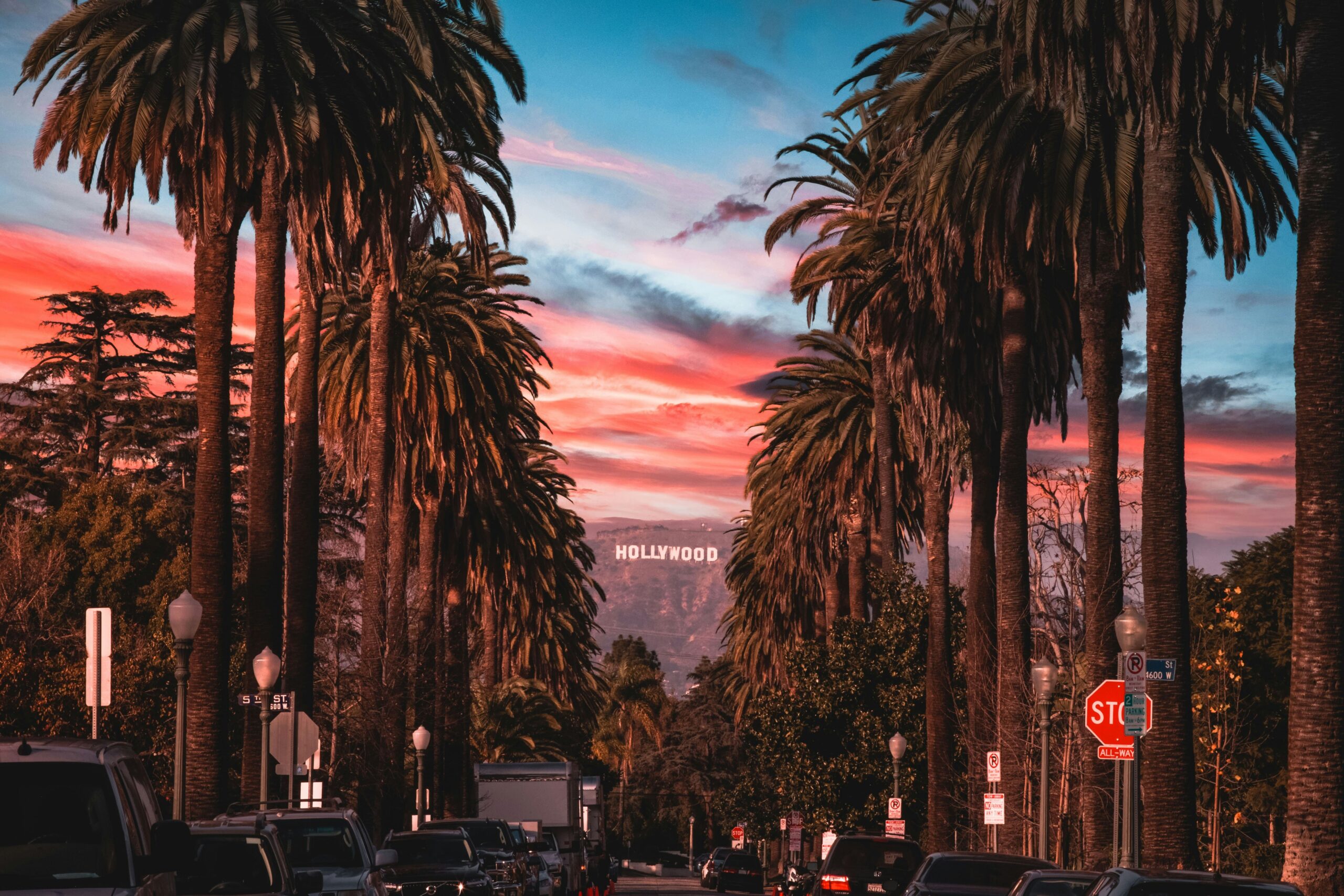
Los Angeles, the sprawling metropolis of nearly 4 million people, represents everything that makes California fascinating: diversity, creativity, ambition, and endless sunshine. As one of the top 10 places to go in California, LA demands multiple visits to truly appreciate its many facets truly. This is where the American Dream gets manufactured, packaged, and exported to the world through movies, television, and music.
Hollywood: Where Dreams Come True
Hollywood Boulevard, despite its sometimes gritty reality, remains one of LA’s most visited attractions. The Hollywood Walk of Fame stretches 15 blocks along Hollywood Boulevard and three blocks on Vine Street, featuring over 2,700 stars embedded in the sidewalk honoring entertainment industry legends. Finding your favorite celebrity’s star becomes a treasure hunt that can consume hours.
The TCL Chinese Theatre (formerly Grauman’s Chinese Theatre) has hosted movie premieres since 1927. Its forecourt features handprints and footprints of legendary stars set in cement, placing your hands in the prints of Marilyn Monroe or Humphrey Bogart creates a tangible connection to Hollywood’s golden age. The theater still hosts premieres and offers tours revealing its ornate interior.
For panoramic views of the Hollywood Sign and the city beyond, hike up to the Griffith Observatory in Griffith Park. This Art Deco landmark offers free admission to its exhibits about astronomy and space exploration, plus several telescopes for public viewing. The observatory’s location on the southern slope of Mount Hollywood provides spectacular views, particularly at sunset when the city begins to sparkle with lights.
Beverly Hills and Rodeo Drive
Beverly Hills embodies wealth and glamour unlike anywhere else in the world. Rodeo Drive, a three-block stretch of luxury boutiques, showcases fashion’s most exclusive brands, Gucci, Prada, Louis Vuitton, Chanel, and dozens more. Even if your budget doesn’t stretch to a $10,000 handbag, window shopping and people-watching here constitute a quintessential LA experience.
Beyond the shopping, Beverly Hills charms visitors with its perfectly manicured streets, lush parks, and stunning architecture. The Beverly Hills Hotel, the legendary “Pink Palace,” has hosted celebrities and dignitaries since 1912. Even if you can’t afford a room, stop by for a cocktail at the Polo Lounge or take photos of the iconic exterior. For a self-guided tour of celebrity homes, drive through the winding streets of the hills, numerous maps and apps identify the estates of current and former stars, though privacy walls limit what you’ll actually see.
Santa Monica and Venice Beach
The beaches of Los Angeles County offer a very different side of the city. Santa Monica Pier, with its solar-powered Ferris wheel and historic carousel, captures the classic California beach experience. The pier hosts free concerts in summer, a weekly farmers market, and an aquarium underneath. The adjacent beach stretches for 3.5 miles, perfect for swimming, surfing, or simply soaking up the California sunshine.
Third Street Promenade, a pedestrian-only outdoor mall three blocks from the pier, buzzes with street performers, restaurants, and shops. This is where you’ll find both mainstream retailers and local boutiques, along with some of the best people-watching in LA.
Venice Beach, just south of Santa Monica, is where LA’s eccentricity shines brightest. The Venice Boardwalk presents a carnival-like atmosphere with street performers, artists, fortune-tellers, bodybuilders pumping iron at Muscle Beach, and vendors selling everything from sunglasses to cannabis products. The Venice Canals, a quieter neighborhood a few blocks inland, recreate the romantic waterways of Venice, Italy, complete with arched bridges and waterfront homes.
Museums and Culture
Los Angeles houses world-class museums rivaling those of any major city. The Getty Center, perched on a hilltop in Brentwood, offers free admission to its impressive collection of European paintings, sculptures, and decorative arts, plus stunning architecture and gardens designed by Richard Meier. On clear days, the views extend from downtown LA to the Pacific Ocean.
The Los Angeles County Museum of Art (LACMA) is the largest art museum in the western United States, with over 150,000 works spanning from ancient times to the present. The iconic “Urban Light” installation at the entrance of 212 restored vintage street lamps has become one of LA’s most photographed artworks.
For contemporary art lovers, The Broad downtown showcases an impressive collection of postwar and contemporary art, including significant works by Jeff Koons, Yayoi Kusama (her Infinity Mirror Rooms require timed reservations), and Jean-Michel Basquiat. The museum’s unique “veil-and-vault” architecture makes it a work of art itself.
Studio Tours and Entertainment
Several major studios offer behind-the-scenes tours revealing movie and television magic. Warner Bros. Studio Tour takes visitors onto working sets and backlots, offering the most authentic studio experience. You might witness actual production if filming is underway. Universal Studios Hollywood combines a studio tour with a theme park featuring rides based on blockbuster films.
For television audiences, free tickets to live tapings of shows offer an insider’s view of Hollywood production. Shows like “Jimmy Kimmel Live,” “The Price is Right,” and various sitcoms welcome studio audiences to request tickets several weeks in advance through the shows’ websites.
Top 10 Places to Eat in California: LA Highlights
Los Angeles’ culinary scene reflects its diverse population, offering authentic cuisines from around the world. The city has become particularly famous for its food truck culture, Korean BBQ, and fusion cuisine.
For iconic LA dining, start with an In-N-Out burger. This California institution serves simple, fresh burgers that have achieved cult status. Order “Animal Style” for grilled onions, extra spread, and pickles. Pink’s Hot Dogs on La Brea Avenue has served celebrity customers and regular folks since 1939, offering over 30 varieties of hot dogs.
Grand Central Market downtown brings together dozens of vendors under one historic roof. Sample tacos from Tacos Tumbras a Tomas, Thai curry from Sticky Rice, or artisanal coffee from G&B Coffee. The market represents LA’s culinary diversity in a microcosm.
For upscale dining, LA offers hundreds of excellent options. Providence serves some of the finest seafood in the country, while Republique transforms a historic building into a French-inspired restaurant and bakery that draws crowds from opening to close.
4. San Diego: America’s Finest City
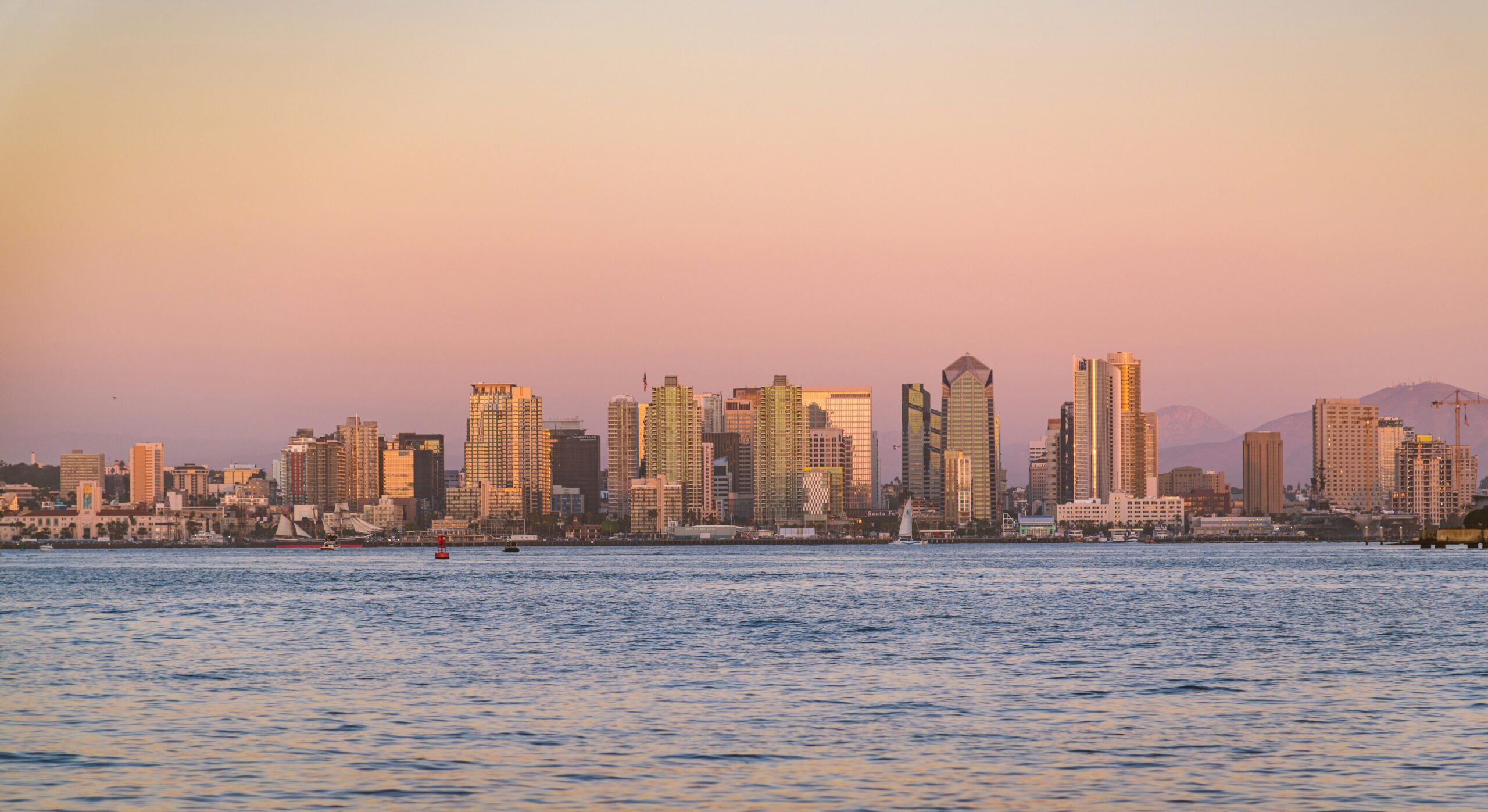
San Diego, California’s southernmost major city, claims the title “America’s Finest City” with good reason: near-perfect weather year-round, 70 miles of pristine beaches, world-class attractions, and a laid-back vibe that encourages visitors to slow down and enjoy life. As one of the top 10 places to visit in California, San Diego offers something for everyone, from families to outdoor enthusiasts to history buffs.
Balboa Park: Cultural Heart of the City
Balboa Park ranks as one of America’s finest urban cultural parks, spanning 1,200 acres and containing 17 museums, multiple gardens, the famous San Diego Zoo, and stunning Spanish Colonial Revival architecture built for the 1915 Panama-California Exposition. You could easily spend several days exploring everything the park offers.
The museums cover an impressive range of subjects. The San Diego Museum of Art houses works from all major artistic periods. The Fleet Science Center engages visitors with interactive exhibits and an IMAX theater. The Air & Space Museum displays actual aircraft, from vintage biplanes to modern jets. The Museum of Photographic Arts showcases contemporary and historical photography in thought-provoking exhibitions.
The gardens within Balboa Park deserve their own visit. The Botanical Building, one of the world’s largest lath structures, contains over 2,100 plant species in a jungle-like setting. The Japanese Friendship Garden offers tranquility with its koi ponds, bonsai exhibits, and traditional tea house. The Rose Garden blooms with over 1,600 roses of approximately 130 varieties, creating a fragrant and colorful display.
San Diego Zoo and Safari Park
The San Diego Zoo consistently ranks among the world’s best zoos, home to over 3,700 animals representing more than 650 species. The zoo pioneered the concept of open-air, cageless exhibits that replicate natural habitats. Highlights include the Giant Panda Research Station (check current availability as pandas sometimes travel to China), the Polar Bear Plunge with its underwater viewing area, and the Elephant Odyssey showcasing the connection between today’s animals and their extinct counterparts.
The Africa Rocks exhibit, the zoo’s newest major addition, takes visitors on a journey through the African continent’s diverse habitats, from penguin colonies on the southern coast to Ethiopian mountains and Madagascar forests. The guided bus tour and Skyfari aerial tram provide overviews of the entire zoo and rest for weary feet.
About 30 miles north, the San Diego Zoo Safari Park offers a different but equally impressive experience. This 1,800-acre facility allows animals to roam in large, open enclosures resembling their natural habitats. The Africa Tram tour, included with admission, provides close encounters with giraffes, rhinos, and numerous African species. For an upcharge, cart safaris and ziplines offer more adventurous ways to experience the park.
La Jolla: Coastal Gem
La Jolla (pronounced “La Hoya”), meaning “The Jewel” in Spanish, lives up to its name with dramatic coastal cliffs, pristine beaches, excellent restaurants, and upscale boutiques. This affluent neighborhood within San Diego feels like a separate seaside village with its own distinct character.
La Jolla Cove, a small beach surrounded by cliffs, offers exceptional snorkeling and diving in the protected marine sanctuary. The crystal-clear water teems with colorful fish, and you’ll likely spot sea lions sunbathing on the rocks or swimming nearby. The cove’s beauty makes it one of the most photographed spots in Southern California.
Children’s Pool Beach, despite its name, has been taken over by harbor seals and sea lions. During pupping season (December through May), you might see dozens of seals hauled out on the beach with their pups. While swimming here is no longer recommended due to the resident pinnipeds, viewing these marine mammals in their natural habitat from the seawall provides an unforgettable experience.
The La Jolla Underwater Park, a 6,000-acre ecological reserve, protects the marine environment while allowing diving, snorkeling, and swimming. Leopard sharks gather in the shallow waters of La Jolla Shores Beach from June through November, creating a unique snorkeling opportunity. These docile sharks pose no threat to humans and tolerate close observation.
Coronado Island and Hotel del Coronado
Coronado Island, connected to downtown San Diego by the stunning Coronado Bridge, feels like a step back to a more genteel era. The main attraction is the legendary Hotel del Coronado, a Victorian beach resort that has hosted presidents, celebrities, and royalty since 1888. The hotel’s distinctive red-roofed turrets and white wooden façade make it one of California’s most iconic buildings.
Even if you’re not staying at the hotel, you can tour the property, dine at one of its restaurants, or relax at the beach bar. The adjacent Coronado Beach consistently ranks among America’s best beaches, with its wide, flat shore and fine golden sand that contains tiny flecks of mica that sparkle in the sunlight.
Orange Avenue, Coronado’s main street, offers charming boutiques, restaurants, and the Coronado Ferry Landing with its shops and waterfront dining. The ferry connecting Coronado to downtown San Diego provides a scenic and practical way to travel between the two areas.
Gaslamp Quarter and Downtown
The Gaslamp Quarter, San Diego’s historic heart and entertainment district, spans 16½ blocks of Victorian-era buildings now housing restaurants, nightclubs, shops, and galleries. The neighborhood comes alive at night when the gas lamps illuminate the streets and crowds flock to its numerous venues. The quarter offers something for every taste, from craft cocktail bars to dance clubs to live music venues.
The USS Midway Museum, permanently docked at Navy Pier downtown, allows visitors to explore this retired aircraft carrier that served from 1945 to 1992. The self-guided audio tour, narrated by former Midway sailors, leads through the hangar deck, flight deck, and living quarters. Restored aircraft on display include F-14 Tomcats, F-4 Phantoms, and other Cold War-era planes. Flight simulators and guided tours by docents, many of them Midway veterans add depth to the experience.
California Travel Tips for San Diego
San Diego’s Mediterranean climate means almost any time is good to visit, though the city sees peak tourism in summer. September and October offer ideal conditions: warm weather, smaller crowds, and lower prices than summer months. The city hosts numerous events throughout the year, including Comic-Con in July (requiring months-in-advance planning) and the Del Mar Racing Season in summer.
Consider the Go San Diego Card or Southern California CityPASS if you plan to visit multiple attractions. These discount passes can save significant money on admission fees. Many beaches offer free parking in designated lots, though popular spots fill early on summer weekends. Public transportation, including trolleys and buses, provides affordable access to major attractions.
5. Lake Tahoe: Alpine Paradise
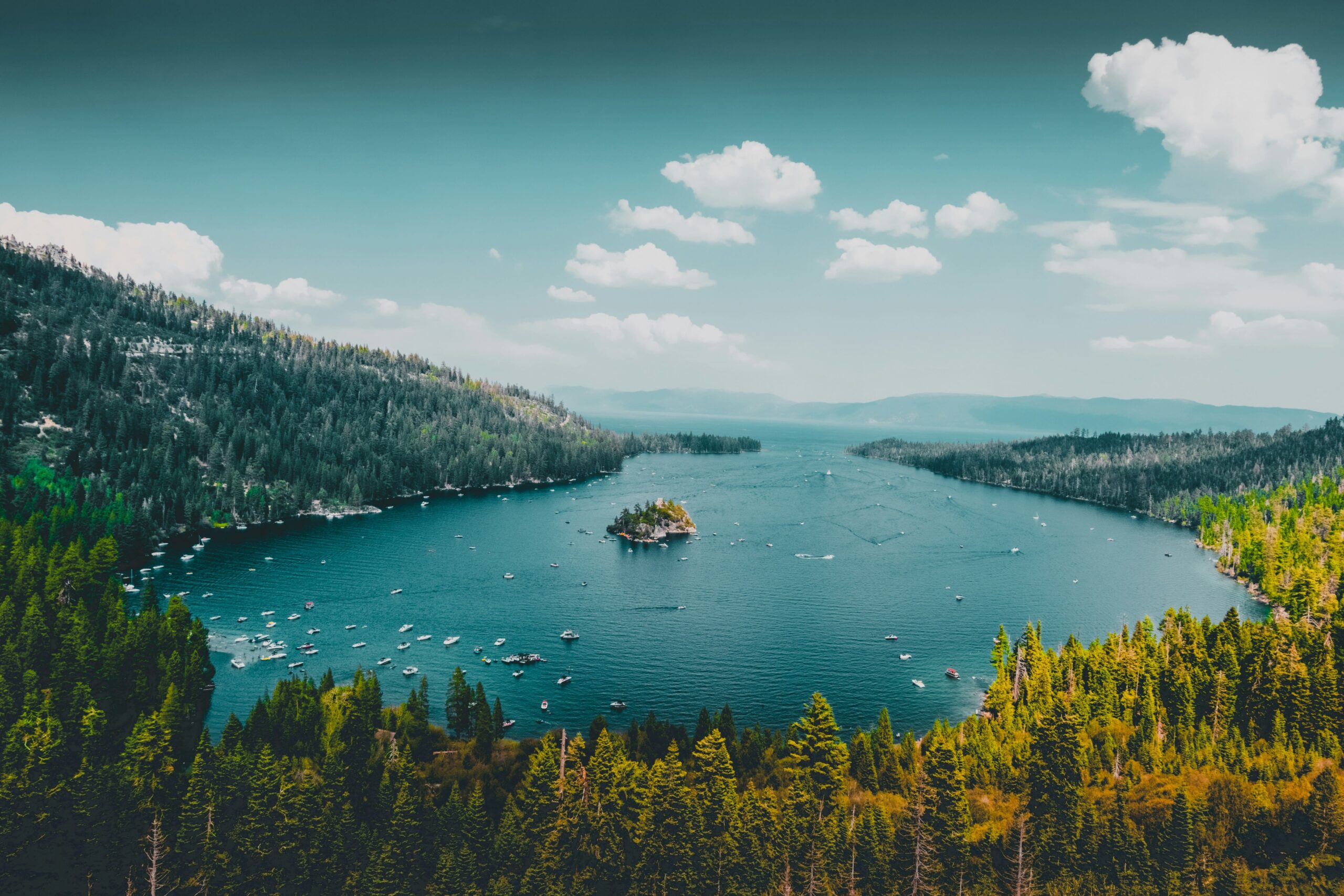
Straddling the California-Nevada border high in the Sierra Nevada Mountains, Lake Tahoe represents one of nature’s masterpieces. This is the largest alpine lake in North America and the second-deepest lake in the United States, holding enough water to cover the entire state of California to a depth of 14 inches. The lake’s famous clarity, you can see objects 70 feet below the surface, and its stunning setting surrounded by snow-capped peaks, make it one of the most beautiful places on Earth and an essential entry in any list of the top 10 places in California.
Year-Round Outdoor Recreation
Lake Tahoe functions as a four-season destination, offering completely different experiences depending on when you visit. Summer transforms the area into a paradise for water sports and hiking. The lake’s 72-mile shoreline provides endless opportunities for swimming, kayaking, paddleboarding, and boating. Several beaches, including Sand Harbor on the Nevada side and Emerald Bay on the California side, offer stunning settings for sunbathing and swimming, though even in summer, the water temperature rarely exceeds 68°F due to the lake’s depth.
Winter converts Tahoe into one of America’s premier ski destinations, with world-class resorts like Palisades Tahoe (formerly Squaw Valley, site of the 1960 Winter Olympics), Heavenly, Northstar, and Kirkwood offering thousands of acres of skiable terrain. The reliable snowfall, averaging 300-500 inches annually, and a long season (typically November through May) attracts skiers and snowboarders from around the world. Even non-skiers find plenty to do, from snowshoeing and cross-country skiing to sledding and snow tubing.
Spring and fall offer quieter times to visit, with fewer crowds and often spectacular weather. Fall foliage transforms the aspens into golden canopies, while spring wildflowers carpet the meadows, and waterfalls roar with snowmelt.
Emerald Bay State Park
Emerald Bay, often called the most photographed location in Lake Tahoe, justifies its reputation with every view. This three-mile-long inlet features brilliant emerald-green water (hence the name) and a tiny granite island called Fannette Island, the only island in Lake Tahoe. The scenic overlook on Highway 89 provides the classic view that appears on countless calendars and postcards.
Vikingsholm Castle, nestled at the head of Emerald Bay, ranks among America’s finest examples of Scandinavian architecture. Built in 1929 as a summer home, this 38-room mansion incorporates design elements from various Scandinavian centuries. To reach the castle requires a steep one-mile hike down from the parking area (and back up the equivalent of climbing a 40-story building), but tours of the interior, offered in summer, reveal intricate details and craftsmanship. The castle’s location, with the bay and mountains as its backdrop, is simply spectacular.
The bay also offers excellent kayaking, with calm waters and the opportunity to paddle to Fannette Island and explore its small stone teahouse ruins. Several outfitters in the area rent kayaks and offer guided tours.
The Rubicon Trail and Other Hiking Adventures
The Rubicon Trail, considered one of Tahoe’s most scenic hikes, follows the southwestern shore of the lake from D.L. Bliss State Park to Emerald Bay, covering about 4.5 miles one way. The trail stays close to the shoreline, offering constantly changing views of the impossibly blue water, granite boulders, and pine forests. Crystal-clear coves and small beaches invite swimmers to cool off on hot days.
For more challenging hiking, the Tahoe Rim Trail circles the entire lake basin, covering 165 miles through varied terrain. Most visitors tackle shorter sections rather than the entire trail. Popular segments include the climb to Mount Tallac, which offers 360-degree views of Lake Tahoe and Desolation Wilderness, and the Flume Trail on the Nevada side, a relatively easy but spectacularly scenic route combining hiking and mountain biking.
Desolation Wilderness, adjacent to Lake Tahoe’s western shore, protects over 63,000 acres of pristine alpine wilderness. More than 130 lakes dot this granite landscape, offering excellent backpacking, fishing, and photography. Day hiking to destinations like Eagle Falls and Velma Lakes provides a taste of this spectacular terrain. A free wilderness permit is required for day use and overnight camping.
South Lake Tahoe and Heavenly Village
South Lake Tahoe, the largest city in the basin, serves as the main hub for dining, shopping, and entertainment. The Heavenly Village area features a pedestrian plaza with restaurants, shops, and the Heavenly Gondola, which whisks visitors 2.4 miles up the mountain to an observation deck with panoramic views of the lake and surrounding peaks. Even if you don’t ski, the summer gondola ride and mountaintop activities make it worthwhile.
North Shore Tranquility
The North Shore of Lake Tahoe offers a quieter, more laid-back alternative to the busier South Shore. Tahoe City serves as the main town, with a charming downtown area featuring local shops and restaurants. Nearby, Squaw Valley’s Village at Palisades Tahoe buzzes with activity year-round, offering shopping, dining, and summer activities like hiking, swimming, and the aerial tram ride to High Camp.
Kings Beach and Incline Village provide additional North Shore amenities, while smaller communities like Carnelian Bay and Dollar Point offer peaceful residential areas with stunning lake views. The North Shore also provides easier access to Truckee, a historic railroad town with authentic Old West character, excellent restaurants, and craft breweries.
6. Big Sur: California’s Dramatic Coast
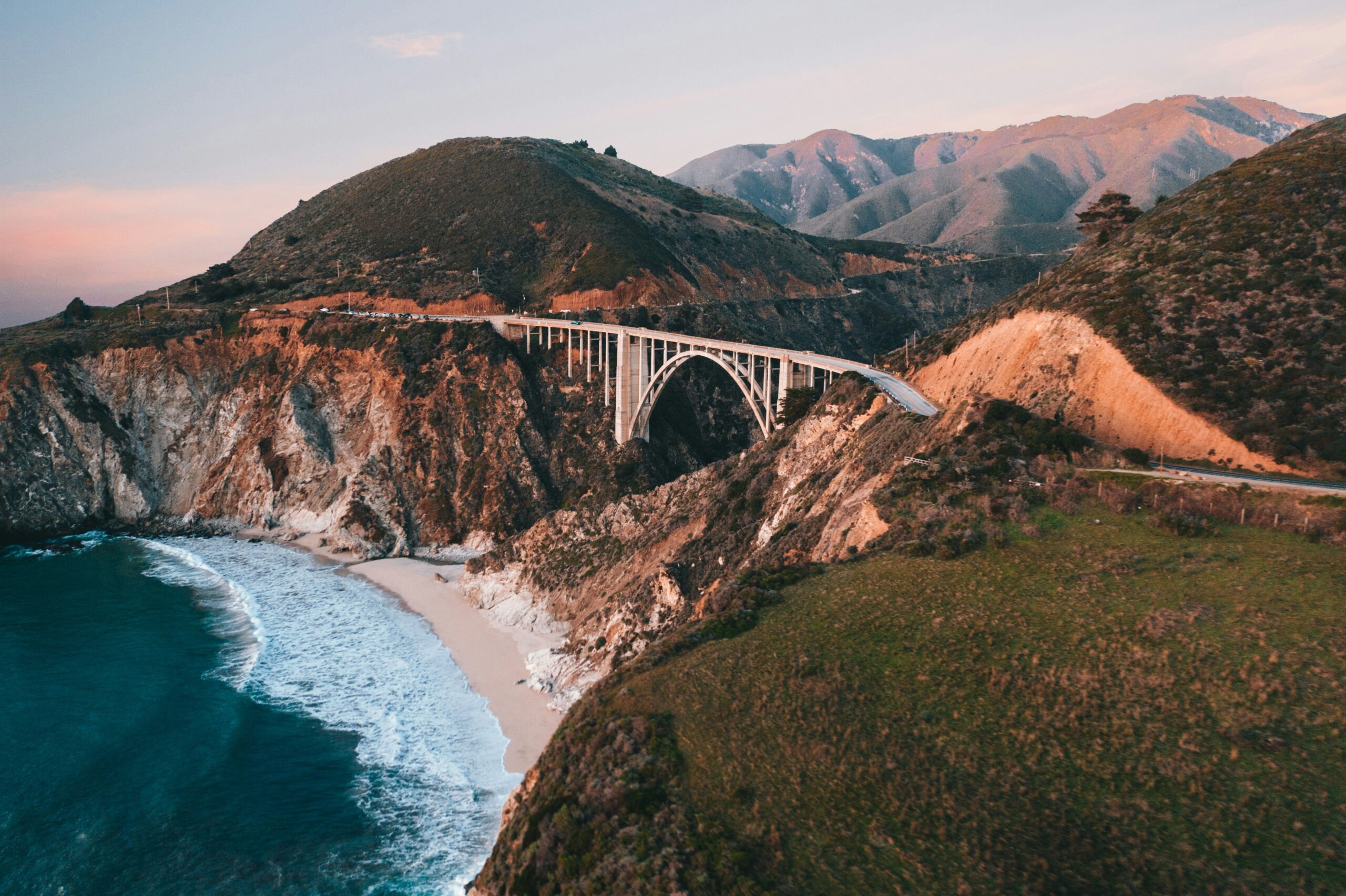
Big Sur, a 90-mile stretch of California’s central coast between Carmel and San Simeon, represents one of the most breathtaking coastal drives on Earth. The name “Big Sur” comes from “el sur grande,” Spanish for “the big south,” referring to this region’s location south of the Monterey Bay area. This sparsely populated region, where the Santa Lucia Mountains rise dramatically from the Pacific Ocean, remains relatively undeveloped, preserving its wild beauty.
Highway 1: The Ultimate Scenic Drive
Highway 1 through Big Sur ranks among the world’s most spectacular drives. The two-lane road clings to cliffsides hundreds of feet above the churning Pacific, curves around headlands offering sweeping ocean views, and occasionally dips into valleys filled with coastal redwoods. Every turn reveals another postcard-worthy scene: rocky cliffs plunging into the sea, offshore rocks where sea lions bark, and crashing waves sending spray high into the air.
Bixby Bridge, one of the world’s highest single-span concrete bridges, has become an icon of the California coast. Built in 1932, this elegant arch bridge spans a deep canyon 280 feet above Bixby Creek. The view from the pullout on the north side captures the bridge with the dramatic coastline stretching beyond it. This is one of the most photographed bridges in California, and for good reason.
The drive requires patience; the twisty road and frequent slow-moving traffic mean you won’t cover the distance quickly. But rushing would defeat the purpose. Take your time, pull over at the numerous vista points, and soak in the majesty of this coastline.
McWay Falls and Julia Pfeiffer Burns State Park
McWay Falls, an 80-foot waterfall that drops directly onto the beach (or into the ocean during high tide), creates one of Big Sur’s most iconic scenes. This rare “tidefall” is visible from an overlook trail in Julia Pfeiffer Burns State Park. The turquoise water, white sand beach, and waterfall combine to create a scene that looks almost tropical despite the Northern California location.
The beach itself is inaccessible to the public, which has helped preserve its pristine condition. The short Overlook Trail provides the perfect vantage point for photographs and contemplation. Visit during golden hour when the setting sun illuminates the falls and cove with warm light.
Julia Pfeiffer Burns State Park also offers several other trails, including the challenging Ewoldsen Trail, which climbs through redwood groves to ridgetop views of the ocean. The park’s diverse ecosystems, from coastal bluffs to redwood forests, demonstrate the remarkable biodiversity of the Big Sur region.
Pfeiffer Big Sur State Park
Pfeiffer Big Sur State Park, one of California’s oldest state parks, provides the best access to Big Sur’s interior forests. The Big Sur River runs through the park, creating a verdant corridor of redwoods, sycamores, and cottonwoods. The Valley View Trail offers an excellent introduction to the park, climbing through redwood groves to a viewpoint overlooking the Big Sur Valley and the Pacific beyond.
The park’s campground, situated along the river beneath towering redwoods, offers one of Big Sur’s most affordable accommodation options. Even if you’re not camping, hiking the park’s trails provides a welcome contrast to the coastal views the quiet forest environment feels worlds away from the ocean just a few miles distant.
Nearby Pfeiffer Beach, accessed via a narrow, unmarked road (look for a yellow sign reading “Narrow Road” rather than a beach sign), features purple-tinted sand created by manganese garnet particles washing down from the hillsides. The beach’s most distinctive feature is the natural keyhole arch in one of the offshore rocks, which perfectly frames the sunset on clear evenings.
Point Lobos State Natural Reserve
Just south of Carmel, Point Lobos State Natural Reserve protects one of California’s most beautiful coastal areas. The reserve’s name comes from “Point of the Sea Wolves,” referring to the sea lions that bark from offshore rocks. This relatively small reserve (1,325 acres) packs tremendous beauty into a compact area, with rocky headlands, hidden coves, and the southernmost naturally growing stand of Monterey cypress trees.
Several easy trails loop through the reserve, including the Cypress Grove Trail, which passes through a ghostly forest of wind-sculpted cypress trees clinging to granite headlands. Bird Island Trail offers excellent wildlife viewing sea lions, sea otters, harbor seals, and, during migration seasons (December-May), gray whales passing close to shore. The reserve’s coves, including China Cove and Gibson Beach, rival anything in the Caribbean for sheer beauty.
Point Lobos also offers some of California’s best diving and snorkeling in its underwater reserve, which protects 750 acres of kelp forests and marine life. A permit system limits the number of divers, maintaining the pristine conditions. Even from shore, you can often spot sea otters floating on their backs, cracking open shellfish with rocks, one of nature’s delightful displays.
Andrew Molera State Park and Beach
Andrew Molera State Park, Big Sur’s largest state park, encompasses nearly 4,800 acres of meadows, beaches, and ridges. The park offers 15 miles of trails, ranging from the easy Beach Trail to the challenging Ridge Trail, which climbs to spectacular ocean views. The park’s relative lack of development (compared to other Big Sur parks) gives it a wilder feeling.
The beach at Andrew Molera, reached via a gentle one-mile walk through meadows and across the Big Sur River (wade or use stepping stones), stretches for miles with few visitors. Beachcombers find driftwood, agates, and solitude. The powerful surf and frigid water make swimming dangerous, but the beach’s beauty and peace make it perfect for walking and contemplation.
Hidden Gems in California: Big Sur Edition
Several lesser-known spots along the Big Sur coast reward explorers willing to venture slightly off the main highway. Limekiln State Park features easy trails to historic lime kilns built into the hillside in the 1880s, plus Limekiln Falls, an 80-foot waterfall accessible via a short hike through redwood groves.
Partington Cove, accessible via a short but steep trail from a small pullout, leads to a tunnel hand-carved through solid rock in the 1880s. The tunnel opens onto a dramatic rocky cove where waves surge into a small inlet. The cove’s isolation and wild beauty make the short challenging hike worthwhile.
For adventurous hikers, the Pine Ridge Trail from Big Sur Station climbs to Sykes Hot Springs, natural hot springs perched above the Big Sur River. The 10-mile one-way hike (20 miles round-trip) ranks as strenuous, but soaking in the hot springs while surrounded by wilderness provides an unforgettable experience. Many hikers camp overnight rather than attempting the full distance in one day.
Practical Considerations for Big Sur
Big Sur has limited services; gas stations are few and expensive, so fill up before you arrive. Cell phone service is spotty to nonexistent throughout much of the region. Lodging options range from rustic campgrounds to luxury resorts like Ventana Big Sur and Post Ranch Inn, but everything books up far in advance during summer and holidays.
The region’s dramatic geology makes Highway 1 vulnerable to landslides and closures, particularly during winter storms. Check road conditions before your visit through Caltrans. Even when open, the road requires careful driving, watch for cyclists, pedestrians, and wildlife, particularly at dawn and dusk.
7. Napa Valley and Sonoma County: Wine Country Paradise
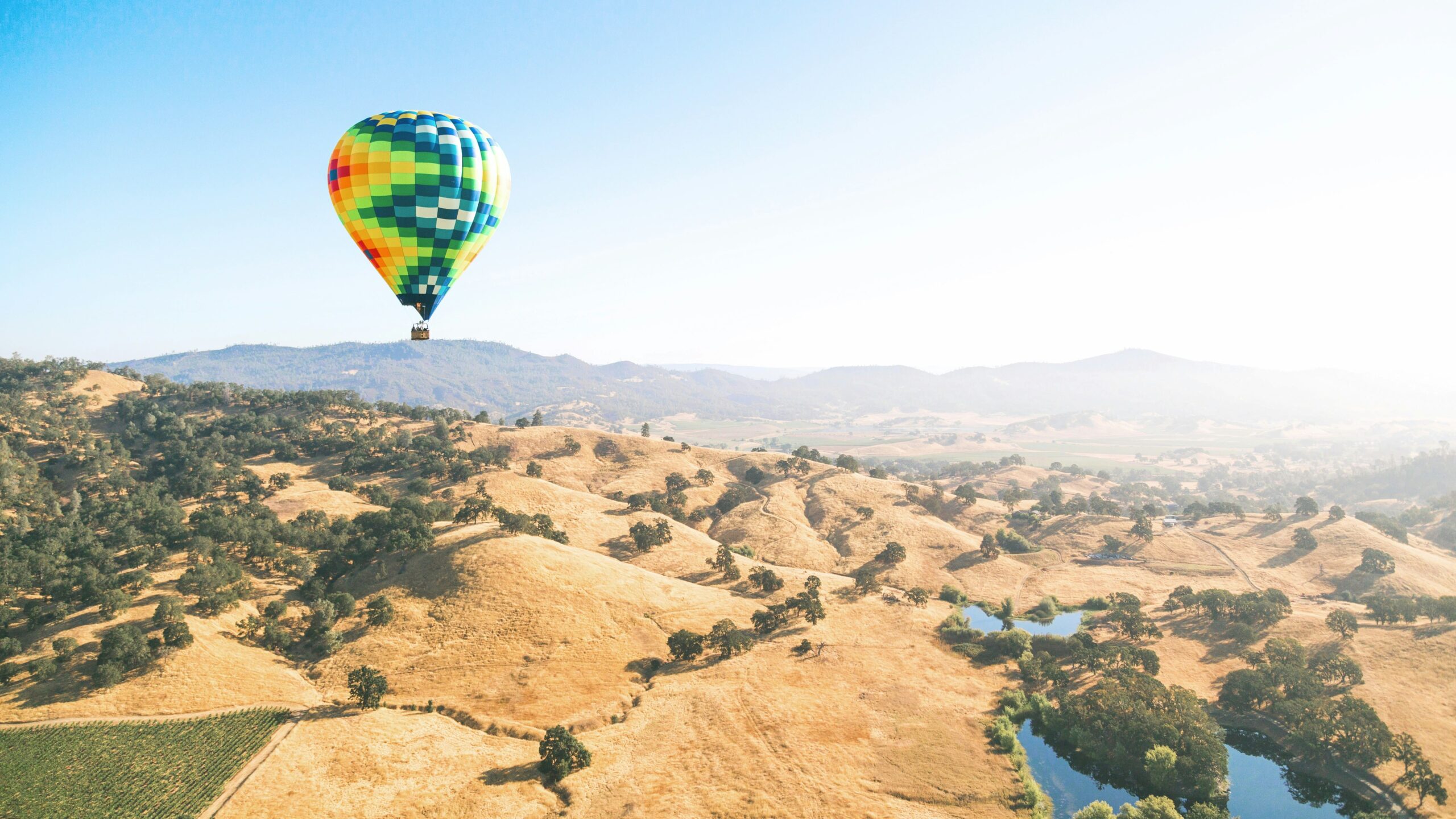
California’s wine country, particularly Napa Valley and neighboring Sonoma County, produces world-class wines while offering stunning landscapes, gourmet cuisine, and luxurious accommodations. While many associate California’s wine regions primarily with upscale experiences, the area offers something for every budget and interest, from casual tastings at family-owned wineries to Michelin-starred dining experiences.
Napa Valley: America’s Premier Wine Region
Napa Valley, just 30 miles long and a few miles wide, contains over 400 wineries producing some of the world’s finest wines, particularly Cabernet Sauvignon. The valley floor and surrounding hillsides feature perfectly manicured vineyards stretching as far as the eye can see, punctuated by stone wine caves, Victorian mansions, and modern architectural statements.
The town of Napa, at the valley’s southern end, has evolved from a sleepy agricultural town into a culinary destination. The Oxbow Public Market brings together local food artisans, wine bars, and restaurants under one roof, offering everything from artisanal cheeses to fresh oysters to gourmet tacos. The downtown area features excellent restaurants, including the French Laundry alumni’s establishments like La Toque and Grace’s Table.
Moving north through the valley, Yountville stands as the epicenter of Napa’s culinary scene. This tiny town hosts more Michelin-starred restaurants per capita than anywhere else in America, including Thomas Keller’s legendary French Laundry (reservations required months in advance and often sell out within minutes). Even if you can’t score a French Laundry reservation, Yountville offers numerous excellent alternatives, from Bouchon Bistro to Bistro Jeanty to Ad Hoc.
St. Helena and Calistoga, further north, maintain more of a small-town feel while still offering world-class wine tasting. Calistoga is particularly known for its hot springs and mud baths, volcanic features that provide relaxing spa experiences after a day of wine tasting. Indian Springs Resort, dating back to 1862, offers the authentic Calistoga mud bath experience, burying yourself in volcanic ash mud mixed with hot spring water.
Sonoma County: Napa’s More Relaxed Neighbor
Sonoma County, larger and more diverse than Napa, produces more wine than Napa while maintaining a more laid-back, less commercialized atmosphere. The county encompasses multiple distinct wine regions, from the cool-climate Sonoma Coast, perfect for Pinot Noir and Chardonnay, to the warmer Dry Creek Valley known for Zinfandel.
The town of Sonoma centers around California’s largest town square, surrounded by historic buildings, restaurants, and tasting rooms. This is where California’s Bear Flag Revolt took place in 1846, and history permeates the area. Mission San Francisco Solano, the last and northernmost of California’s 21 Spanish missions, sits on the square’s corner.
Healdsburg, in northern Sonoma County, has become a wine country destination in its own right. Its charming town square features tasting rooms, boutiques, and some of California’s best restaurants. The town serves as a convenient base for exploring three distinct wine regions Russian River Valley, the Dry Creek Valley, and the Alexander Valley, all converging nearby.
Wine Tasting Strategies and Experiences
With hundreds of wineries to choose from, planning your wine tasting itinerary can feel overwhelming. Most wineries now require reservations, particularly on weekends, so plan. Tastings typically cost $25-75 per person (often waived with wine purchases), with more expensive options including food pairings or special library wines.
For first-time visitors, starting with larger, well-known wineries provides an educational foundation. Wineries like Robert Mondavi in Napa or Kendall-Jackson in Sonoma offer excellent tours explaining winemaking processes. Castello di Amorosa in Napa, a authentically styled 13th-century Tuscan castle, combines wine tasting with impressive architecture.
As you develop your palate, seek out smaller, family-owned wineries offering more intimate experiences. These boutique producers often allow you to meet the winemaker and provide deeper insights into their craft. Some favorites include Stag’s Leap Wine Cellars in Napa (site of the famous 1976 “Judgment of Paris” tasting) and Hartford Family Winery in Sonoma.
For unique experiences, consider hot air ballooning over the vineyards at sunrise. The peaceful flight provides spectacular views of the valley awakening. The Napa Valley Wine Train combines wine tasting with a gourmet meal aboard a vintage train traveling through the valley. Bike tours allow you to pedal between wineries while working off some of those wine calories.
Beyond Wine: Food and Activities
While wine takes center stage, the region’s culinary scene rivals the wines in quality. The top 10 places to eat in California must include several wine country establishments. The French Laundry remains the holy grail for food lovers, but numerous other restaurants showcase seasonal, locally sourced ingredients. SingleThread Farm-Restaurant-Inn in Healdsburg holds three Michelin stars and offers an eleven-course tasting menu that changes with the farm’s harvests.
For more casual dining, stop at Gott’s Roadside for gourmet burgers, The Girl & the Fig in Sonoma for French-inspired country food, or Oakville Grocery for picnic supplies perfect for enjoying at a winery’s picnic grounds.
The region offers activities beyond eating and drinking. Hiking trails wind through the hills. The Oat Hill Mine Trail near Calistoga offers challenging terrain and panoramic valley views. Lake Hennessey provides opportunities for kayaking and fishing. Safari West, an African wildlife preserve in Santa Rosa, features giraffes, zebras, and other African animals on 400 acres of Sonoma County land.
California Travel Tips for Wine Country
The best time to visit Napa and Sonoma depends on your priorities. Harvest season (August-October) offers the excitement of crush, when grapes are picked and processed, but also brings crowds and higher prices. Spring features vibrant mustard flowers blooming between vine rows, creating stunning yellow carpets. Summer offers perfect weather but maximum crowds. Winter sees fewer visitors and lower prices, though some wineries reduce their hours.
Designate a driver, hire a driver, or join a tour. California takes drunk driving seriously, and the winding roads can be dangerous. Many visitors stay in Napa or Sonoma and use ride-sharing services or tour companies to handle transportation between wineries.
Lodging ranges from budget motels to ultra-luxury resorts like Meadowood Napa Valley and Auberge du Soleil. For mid-range options with charm, consider bed-and-breakfasts. Wine country has dozens offering personal attention and local insights.
8. Redwood National and State Parks: Among Giants
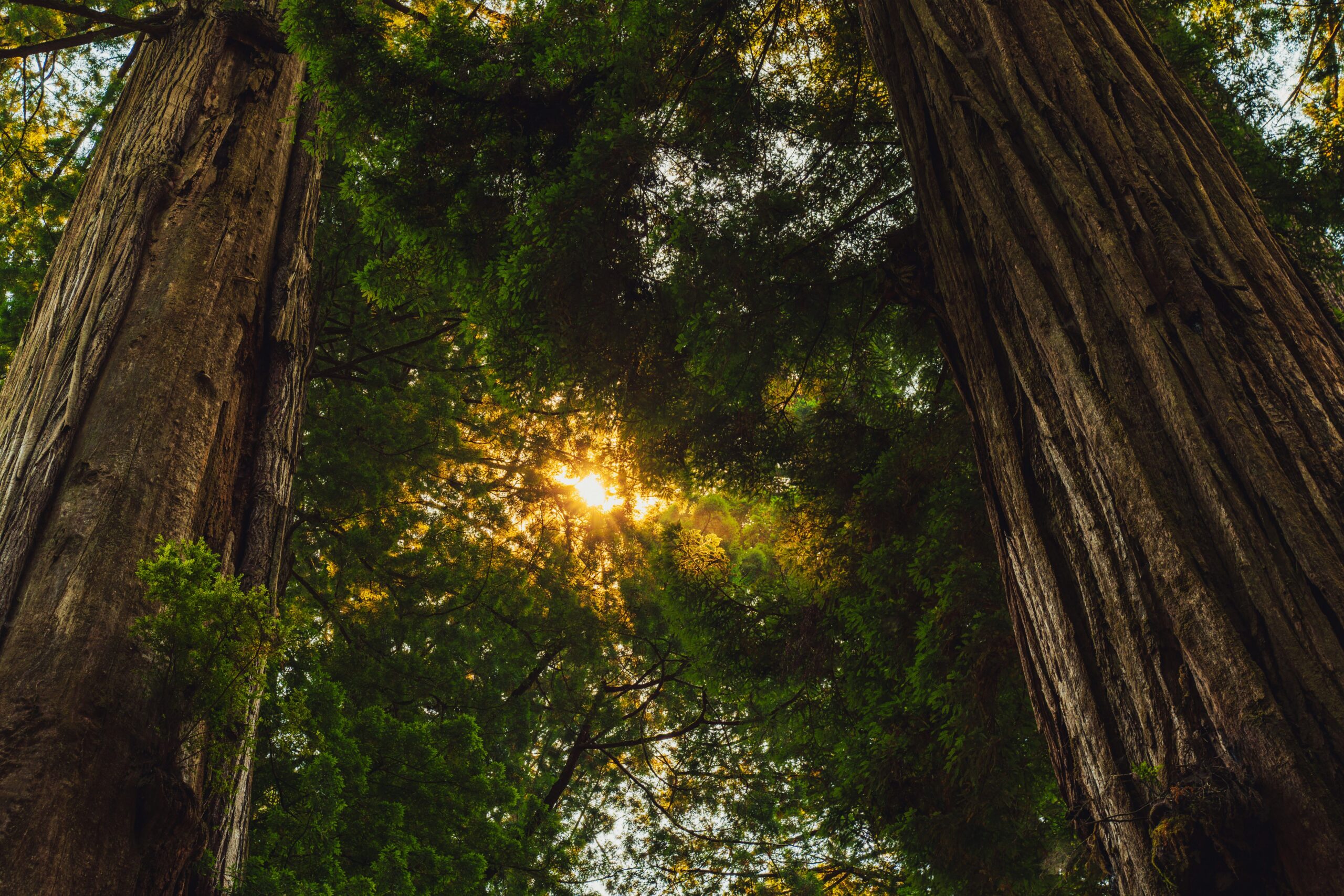
Northern California’s Redwood National and State Parks preserve roughly half of all remaining old-growth coast redwood forests, protecting these ancient giants that rank as the tallest trees on Earth. Walking among these 300-foot-tall trees, some over 2,000 years old, provides a humbling perspective on time, scale, and nature’s power. This is truly one of the hidden gems in California that deserves far more attention than it receives.
The Avenue of the Giants
The Avenue of the Giants, a 31-mile scenic alternative to Highway 101 through Humboldt Redwoods State Park, provides an excellent introduction to the redwoods. This historic highway winds beneath a cathedral-like canopy of massive trees, with numerous pullouts offering short walks into the groves. The park contains Rockefeller Forest, the world’s largest remaining contiguous old-growth coast redwood forest.
Several drive-through trees along the avenue offer kitschy photo opportunities, while these scarred trees represent outdated attitudes toward conservation, they’ve become beloved roadside attractions. The Shrine Drive-Thru Tree and Chandelier Drive-Thru Tree accommodate most cars, though large vehicles should take caution.
Stop at the Humboldt Redwoods State Park Visitor Center to learn about redwood ecology and history. Rangers can recommend hikes matching your interests and abilities. The Founders Grove Nature Trail, an easy half-mile loop, passes by the Dyerville Giant, a 370-foot-tall tree that fell in 1991 after standing for an estimated 1,600 years. Even lying on its side, the tree’s massive size astounds visitors.
Prairie Creek Redwoods State Park
Prairie Creek Redwoods State Park combines old-growth redwood forests with pristine coastline, creating remarkable biological diversity. The park’s most famous feature, Fern Canyon, appeared in “Jurassic Park 2” and “The Lost World” for good reason. The canyon’s vertical walls, draped with five-fingered ferns, sword ferns, and other species, create a prehistoric atmosphere.
The easy one-mile loop through Fern Canyon involves crossing Prairie Creek multiple times via temporary footbridges placed each summer and removed before winter floods. The canyon walls rise 50 feet, and the lush vegetation creates an enchanted atmosphere. Visit early in the morning for the best light and fewer crowds.
Prairie Creek also features several excellent hiking trails through old-growth forests. The Cathedral Trees Trail, a short loop from the visitor center, passes through a grove of exceptionally tall trees creating a natural cathedral. The James Irvine Trail, a longer option, descends through varied forest types to the coast at Gold Bluffs Beach.
Jedediah Smith Redwoods State Park
Jedediah Smith Redwoods State Park, the northernmost park in the system, contains some of the finest old-growth redwood groves. The park’s location away from the coast means less fog and more sunshine, making it popular for camping and hiking. The Smith River, California’s longest free-flowing river, runs through the park, offering swimming, fishing, and kayaking opportunities.
The Stout Grove Trail, one of California’s most beautiful short hikes, loops for just 0.6 miles through a magnificent old-growth grove. Morning fog filtering through the trees creates magical light for photographers. The grove’s trees, including one over 340 feet tall, demonstrate the heights coast redwoods can reach in ideal conditions.
For a longer adventure, the Boy Scout Tree Trail covers 5.6 miles round-trip to a double-trunked tree and a hidden waterfall beyond. The trail showcases the redwood forest’s diversity, from massive old-growth trees to dense understory vegetation.
The Lost Coast and Nearby Attractions
The Lost Coast, south of the main redwood parks, earned its name from its inaccessibility steep mountains plunging directly to the ocean made road building impractical. This isolation has preserved one of California’s wildest coastlines. The Lost Coast Trail, a multi-day backpacking route, challenges hikers with its rugged terrain, but day hikes from Shelter Cove or Mattole provide access to deserted black-sand beaches and dramatic coastal scenery.
Nearby Trinidad, a charming coastal town, offers excellent dining, whale watching opportunities, and the Trinidad Head Trail with panoramic ocean views. The town serves as a convenient base for exploring both the redwoods and the coast. Patrick’s Point State Park, just north of Trinidad, features coastal bluffs, tide pools, and the reconstructed Yurok village of Sumêg, offering insights into the Native American culture that has thrived in this region for thousands of years.
What to Do in California: Redwood Region
Beyond simply walking among the trees, the redwood region offers diverse activities. Kayaking the Smith River or Humboldt Bay provides water-level perspectives of the forests and opportunities to spot wildlife like river otters and herons. Mountain biking on the many back roads offers a different way to explore, though bikes are prohibited on most trails within the parks.
The region’s rivers and coastal waters offer excellent fishing for salmon and steelhead. Crabbing in Humboldt Bay provides both recreation and dinner. Tide pooling along the coast reveals colorful sea stars, anemones, and other marine life.
Nearby towns like Eureka and Arcata provide Victorian architecture, quirky culture, and good restaurants. Eureka’s Old Town features dozens of preserved Victorian buildings, while Arcata Plaza hosts a farmers’ market and local events. Both towns offer craft breweries, particularly Lost Coast Brewery and Redwood Curtain Brewing.
Timing Your Visit to the Redwoods
Summer brings the most visitors and the best weather, though coastal fog can persist through July and August. Fall offers stunning conditions with clear skies, warm days, and fall colors from the deciduous trees mixed among the evergreen redwoods. Winter sees heavy rain (essential for the redwoods’ survival) and few visitors; those willing to brave the wet weather will have the forests almost to themselves. Spring features wildflowers and the unfurling of new fern fronds, creating particularly vibrant green tones.
The park’s remote location means limited services. Bring supplies from larger towns like Eureka or Crescent City. Several small lodges and campgrounds operate within and near the parks, but booking ahead is wise during summer. The drive from San Francisco takes about 5-6 hours, making this a destination that rewards spending several days rather than trying to squeeze it into a day trip.
9. Death Valley National Park: Extreme Beauty
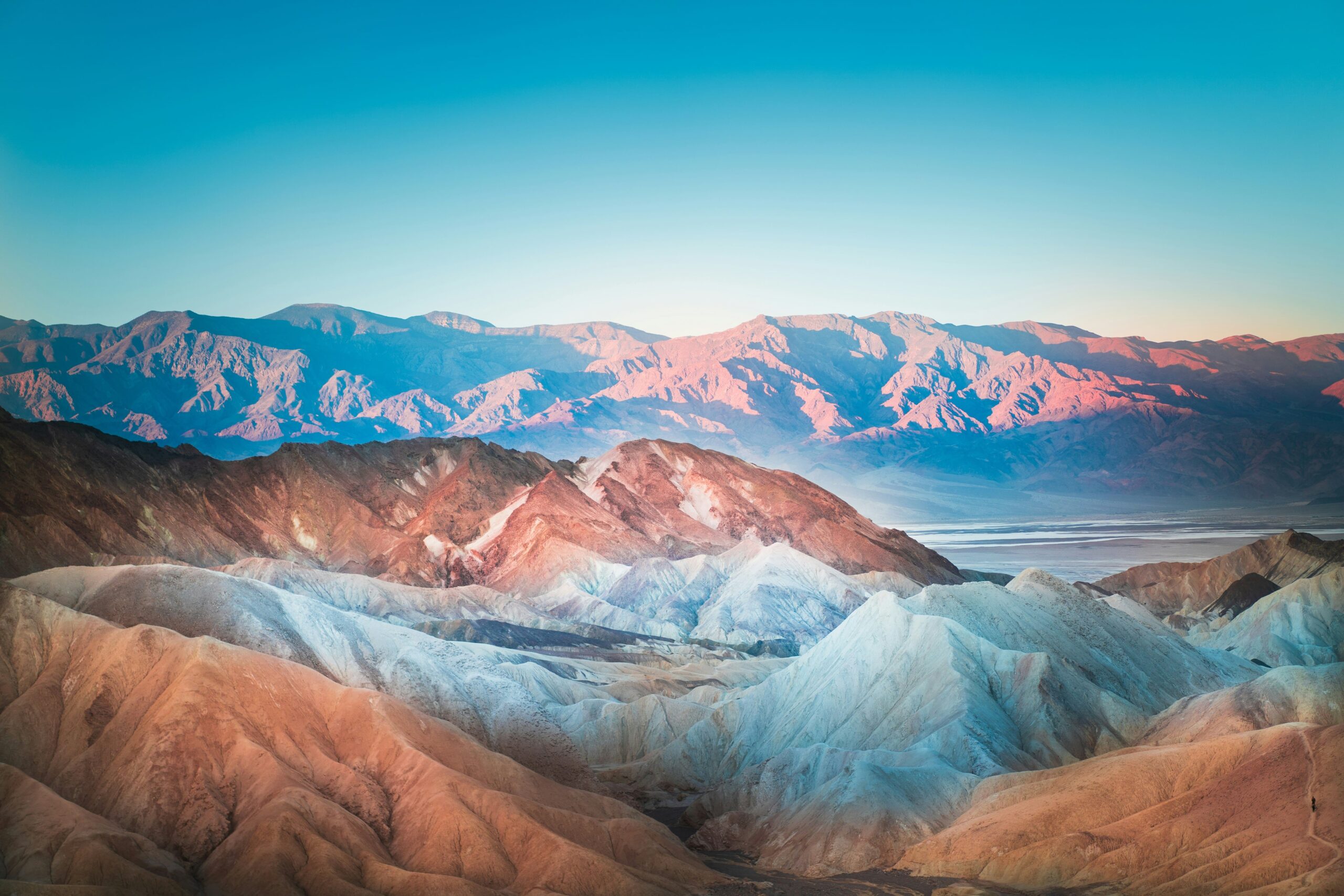
Death Valley, America’s hottest, driest, and lowest national park, presents a landscape so extreme it seems otherworldly. This is a land of superlatives, the highest temperature reliably recorded on Earth (134°F in July 1913), the lowest point in North America (282 feet below sea level at Badwater Basin), and some of the most spectacular geological formations anywhere. Despite its forbidding name and reputation, Death Valley offers extraordinary beauty and surprising life, making it one of the most unique destinations in the top 10 places to visit in California.
Badwater Basin and the Valley Floor
Badwater Basin, at 282 feet below sea level, marks the lowest point in North America. The vast salt flats stretch toward the horizon, creating a surreal white landscape that crunches underfoot. The hexagonal salt formations create natural patterns that photographers love. A short walk from the parking area takes you onto the salt flat. Look back toward the cliff to see a sign marking “Sea Level” mounted high on the cliff face, providing perspective on how far below sea level you’re standing.
The valley floor offers several other remarkable features. The Devil’s Golf Course, a field of jagged salt formations created by cycles of flooding and evaporation, gets its name from a 1934 National Park Service guidebook that stated, “Only the devil could play golf on this surface.” The formations, some several feet tall, create a landscape that looks more like another planet than Earth.
Artist’s Palette, along the Artist’s Drive one-way loop, showcases rocks in an astounding array of colors: reds, pinks, greens, yellows, and purples, created by different mineral oxidations. Late afternoon light, about an hour before sunset, brings out the most vivid colors. The drive also offers excellent views across the valley to the Panamint Range.
Zabriskie Point and Twenty Mule Team Canyon
Zabriskie Point provides Death Valley’s most iconic view of dramatic badlands eroded into countless ridges and valleys, creating a landscape of light and shadow. Sunrise and sunset transform the scene as the changing light angles create constantly shifting patterns. The point is easily accessible via a short uphill walk from the parking area, making it one of the park’s most visited locations.
Twenty Mule Team Canyon, a one-way dirt road loop (suitable for passenger cars in dry conditions), winds through colorful badlands similar to those seen from Zabriskie Point. The close-up perspective reveals the delicate erosion patterns and mineral colors in intimate detail. The canyon gets its name from the twenty-mule teams that hauled borax from Death Valley mines in the 1880s.
Sand Dunes and Unique Landscapes
Mesquite Flat Sand Dunes, located near Stovepipe Wells, offer the most accessible dunes in Death Valley. These wind-sculpted formations reach heights of 100 feet, creating graceful curves and sharp ridgelines against the backdrop of the Grapevine Mountains. Early morning or late afternoon provides the best conditions for photography when low-angle sunlight emphasizes the dunes’ contours and creates long shadows.
Walking on the dunes reveals surprises, animal tracks, wind ripples in perfect patterns, and the occasional mesquite tree struggling to survive in the shifting sands. The dunes feel even more dramatic when you realize they occupy just a tiny fraction of the massive valley.
Ubehebe Crater, in the park’s northern section, demonstrates Death Valley’s volcanic past. This half-mile-wide crater formed about 2,000 years ago when groundwater met hot volcanic rock, creating a violent steam explosion. The trail around the crater rim offers vertiginous views into the 600-foot-deep pit and across the surrounding volcanic landscape.
Telescope Peak and the Mountains
While most visitors focus on the valley floor, the surrounding mountains offer completely different experiences. Telescope Peak, at 11,049 feet, stands as Death Valley’s highest point. The strenuous 14-mile round-trip trail climbs from 8,133 feet at Mahogany Flat Campground to the summit, passing through pinyon pine and juniper forests a stark contrast to the desert floor.
From the summit on clear days, you can see both the lowest point in North America (Badwater Basin) and the highest (Mount Whitney), a span of nearly 15,000 vertical feet. The mountain also occasionally receives snow, creating the surreal sight of snow-capped peaks overlooking the desert floor.
Wildrose Peak, a shorter but still challenging hike (8.4 miles round-trip), offers similar environments and views with less elevation gain. The Charcoal Kilns near the trailhead, beehive-shaped stone structures built in 1876 to produce charcoal for silver smelting, add historical interest.
Ghost Towns and History
Death Valley’s mining history has left numerous ghost towns and historic sites. Rhyolite, just outside the park’s eastern boundary near Beatty, Nevada, once housed 5,000 people during the brief gold boom of 1905-1911. Today, crumbling concrete buildings and the famous Bottle House (built with 50,000 beer and liquor bottles) tell the story of boom and bust in the desert.
Scotty’s Castle, a Spanish Revival mansion in the park’s northern section, told an elaborate tale of a prospector who struck it rich. In reality, wealthy Chicago insurance magnate Albert Johnson built the “castle” as a winter retreat. The mansion sustained significant flood damage in 2015 and remains closed for extensive repairs, though the grounds and some outbuildings can be visited.
Harmony Borax Works preserves the remains of Death Valley’s borax mining operations from the 1880s. The short interpretive trail explains how borax was processed and transported by the famous twenty-mule teams. The adjacent Mustard Canyon trail offers a longer walk through colorful geology.
When to Visit Death Valley
Timing is crucial for enjoying Death Valley. Summer temperatures regularly exceed 120°F, making outdoor activities dangerous if not impossible. The park’s small visitor center keeps “liquid sunshine” (water) available for tourists who underestimate the heat. Even if your car might struggle with radiator failure is common, and you should never drive a car with cooling system issues into Death Valley during summer.
Winter (November-March) offers pleasant daytime temperatures (60-75°F) and is considered the best time to visit. Nights can be cold, especially at higher elevations. Spring (March-April) brings the possibility of wildflower “super blooms” following wet winters when conditions align, the desert floor transforms into carpets of wildflowers in yellow, purple, pink, and white.
Fall (October-November) provides another good window with moderate temperatures and fewer crowds than spring. Whatever time you visit, carry plenty of water (one gallon per person per day minimum), protect yourself from the sun, and tell someone your itinerary.
10. Santa Barbara and the Central Coast: The American Riviera
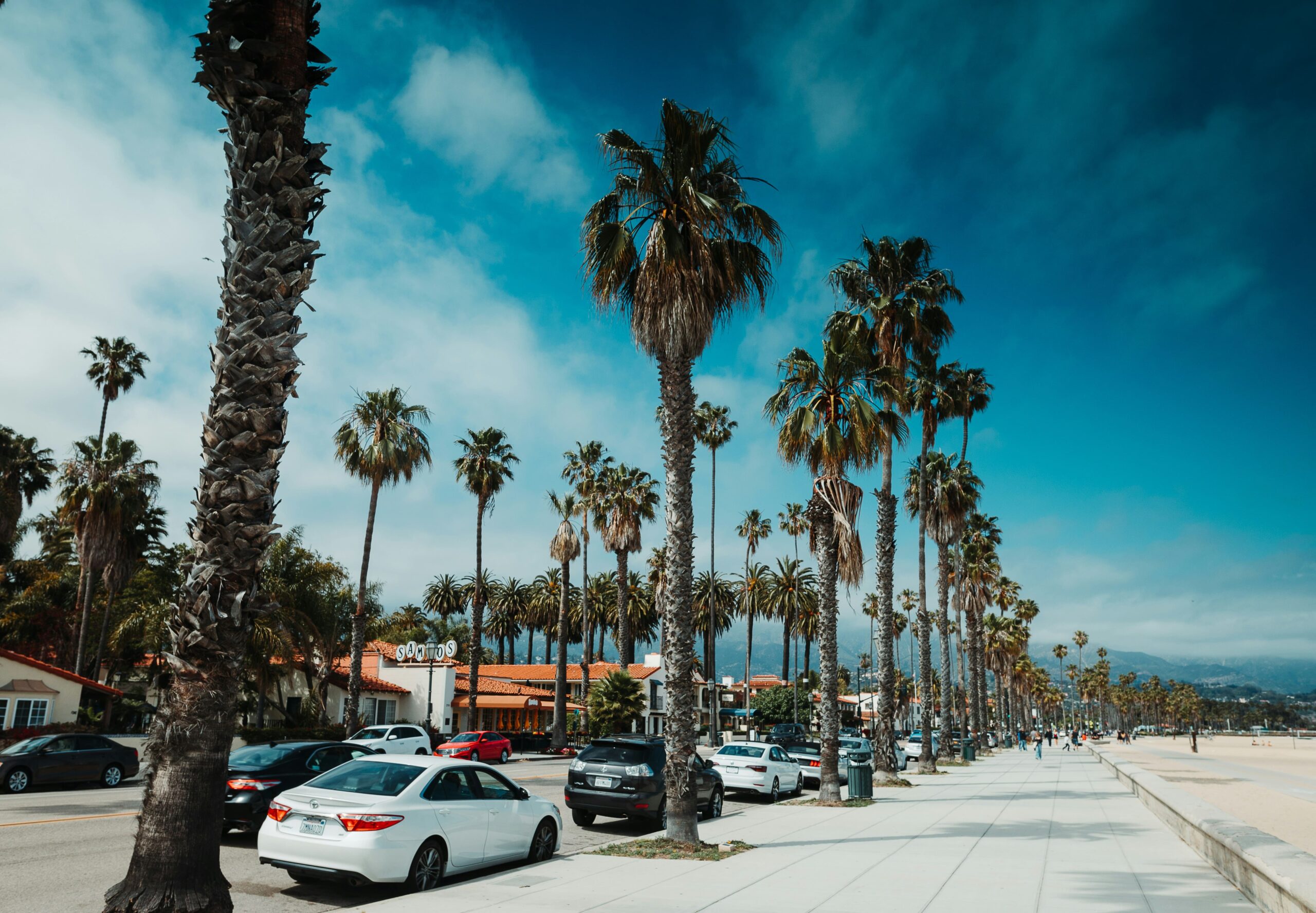
Santa Barbara, often called “The American Riviera,” combines the best of California, living beautiful beaches, Spanish Colonial architecture, excellent dining, and world-class wines from the nearby Santa Ynez Valley. The city’s compact downtown, walkable waterfront, and Mediterranean climate create an atmosphere that invites relaxation. As one of the top 10 places to go in California, Santa Barbara offers a more intimate alternative to LA’s sprawl and San Francisco’s hills.
Mission Santa Barbara and Historical Sites
Mission Santa Barbara, founded in 1786, stands as the “Queen of the Missions,” the most architecturally intact of California’s 21 Spanish missions. The mission’s distinctive twin bell towers, pink façade, and Romanesque design create one of California’s most photographed buildings. The beautiful gardens, cemetery, and museum provide insights into Spanish colonial California and the Chumash people who originally inhabited this region.
The mission’s location on a hill overlooking the city and ocean has made it a spiritual and visual landmark for over 200 years. The mission continues to function as an active parish, giving it a living quality absent from some of the other missions. Self-guided tours allow visitors to explore at their own pace, while docent-led tours provide a deeper historical context.
El Presidio de Santa Barbara State Historic Park preserves the site of the last Spanish fort built in California (1782). The fort housed soldiers who protected the mission and pueblo. Today, reconstructed buildings and archaeological excavations reveal life in Spanish and Mexican California. The chapel, with its vibrant painted decorations, ranks among the presidio’s highlights.
State Street and Downtown
State Street, Santa Barbara’s main thoroughfare, runs from the mountains to the ocean, lined with shops, restaurants, theaters, and Spanish Colonial Revival architecture. The street’s pedestrian-friendly design encourages strolling, window shopping, and café sitting. Unlike many California cities, Santa Barbara maintains strict architectural guidelines requiring buildings to harmonize with the Spanish Colonial theme, creating visual coherence rare in modern America.
The downtown area features numerous galleries showcasing both traditional and contemporary art. The Santa Barbara Museum of Art, though modest in size, offers an impressive collection ranging from ancient Egyptian artifacts to contemporary works. The museum’s highlight is its collection of late-19th and early-20th-century American paintings.
The Granada Theatre, a beautifully restored 1924 Spanish Colonial Revival building, hosts concerts, theater, and films. The Arlington Theatre, an even larger venue, features a unique interior designed to resemble a Spanish village courtyard, complete with twinkling stars on the ceiling.
Beaches and Waterfront Activities
Santa Barbara’s 110 miles of coastline offer something for every beach lover. Butterfly Beach in Montecito attracts celebrities to its upscale neighborhood, while East Beach, the city’s largest and most popular beach, offers volleyball courts, a snack bar, and the nearby Cabrillo Pavilion Bathhouse (a beautiful Spanish Colonial structure from 1925).
Leadbetter Beach, at the west end of the harbor, is favored by surfers and those seeking quieter stretches of sand. Arroyo Burro Beach (locals call it “Hendry’s Beach”) offers tide pools, a beach bar, and is dog-friendly. The long, flat beaches make Santa Barbara perfect for beach walks, especially at sunset when the light bathes the mountains in golden alpenglow.
Stearns Wharf, California’s oldest working wooden wharf, extends into the harbor, providing restaurants, shops, and the Ty Warner Sea Center. The aquarium-like facility offers touch tanks, interactive exhibits about local marine life, and a working laboratory visible to visitors. Walking the wharf provides views of the harbor, mountains, and city, plus opportunities to watch sea lions lounging on the nearby buoys.
Santa Ynez Valley Wine Country
Just 30 minutes north of Santa Barbara, the Santa Ynez Valley offers wine tasting without Napa’s crowds or prices. The valley benefits from the transverse mountain ranges that run east-west rather than north-south, allowing cool ocean air to penetrate inland and create ideal growing conditions for Pinot Noir, Chardonnay, and Syrah.
The charming towns of Los Olivos, Solvang, and Los Alamos each offer distinct characters. Los Olivos functions as the valley’s wine tasting hub, with numerous tasting rooms within walking distance of each other along the town’s main street. Solvang, founded by Danish immigrants in 1911, maintains its Danish village theme with windmills, half-timbered buildings, and bakeries selling æbleskiver (Danish pancake balls). Los Alamos, once a sleepy highway town, has transformed into a foodie destination with excellent restaurants and wine bars.
The valley’s wineries range from small family operations to larger estates. Many offer beautiful grounds perfect for picnicking alongside your wine tasting. The region has also become known for producing excellent olive oils, and several shops offer tastings of locally produced oils.
Channel Islands National Park
Often called “The Galápagos of North America,” Channel Islands National Park protects five islands and their surrounding waters just off Santa Barbara’s coast. The islands support unique plant and animal species found nowhere else on Earth, including the diminutive island fox (about the size of a house cat) and over 145 endemic plant species.
Reaching the islands requires a boat ride (commercial operators provide service from Ventura Harbor), but the journey rewards adventurous visitors with pristine hiking, kayaking, diving, and wildlife viewing. Anacapa Island, the closest and most visited, features a dramatic arch, lighthouse, and colonies of California brown pelicans and western gulls. Santa Cruz Island, the largest, offers more extensive hiking trails, sea caves perfect for kayaking, and opportunities to see island foxes and endemic scrub jays.
The islands maintain a wild, undeveloped character. No services exist on any island, so visitors must bring all supplies and pack out all trash. This preservation of wilderness just miles from millions of people makes the Channel Islands one of California’s most remarkable conservation successes and definitely qualifies as one of the hidden gems in California.
Top 10 Places to Eat in California: Santa Barbara Highlights
Santa Barbara’s culinary scene punches above its weight for a city of just 90,000 people. The Funk Zone, a former industrial area near the waterfront, has transformed into a trendy neighborhood filled with wine tasting rooms, breweries, and restaurants. The Lark, housed in a former fish market, emphasizes seasonal, locally sourced ingredients in shareable plates.
State Street and downtown offer numerous options. La Super-Rica Taqueria, recommended by Julia Child when she lived in Santa Barbara, serves authentic Mexican tacos and tamales from a modest building. The long lines during lunch attest to the quality. Brophy Bros., located at the harbor, serves fresh seafood with harbor views. The clam chowder and fish and chips are local favorites.
For upscale dining, Bouchon Santa Barbara offers wine country-inspired cuisine, while Opal Restaurant and Bar downtown provides contemporary American cuisine with an emphasis on seasonal ingredients. The area’s numerous farm-to-table restaurants benefit from Santa Barbara County’s agricultural bounty, from strawberries to avocados to grass-fed beef.
Hidden Gems in California Beyond the Top 10
While these top 10 places to visit in California offer world-famous attractions and unforgettable experiences, California contains dozens of lesser-known destinations that reward explorers willing to venture off the beaten path.
Eastern Sierra
The Eastern Sierra, running along California’s eastern edge from Mammoth Lakes to Lone Pine, offers dramatic mountain scenery rivaling anything in the Western United States. Mammoth Lakes serves as a year-round outdoor recreation hub with world-class skiing in winter, and hiking, mountain biking, and fishing in summer. The Devils Postpile National Monument features remarkable columnar basalt formations created by ancient lava flows, while Rainbow Falls drops 101 feet in a spectacular display.
The June Lake Loop, a 16-mile scenic drive through four mountain lakes, provides stunning fall colors when aspens turn golden. Mono Lake, an ancient saline lake, supports unique ecosystems including trillions of brine shrimp and alkali flies. The lake’s tufa towers, calcium carbonate formations exposed when water levels dropped, create an otherworldly landscape, especially at sunset.
Alabama Hills and Mount Whitney
The Alabama Hills, near Lone Pine, feature hundreds of rounded granite boulders scattered across a desert landscape with the jagged Sierra Nevada peaks rising dramatically behind. This stark contrast has made the area a favorite filming location for Westerns and science fiction films. Numerous arches, including Mobius Arch, frame views of Mount Whitney, the highest peak in the contiguous United States at 14,505 feet.
Mount Whitney can be climbed via a strenuous 22-mile round-trip trail gaining over 6,000 feet of elevation. The trail requires a permit (obtained through lottery) and typically demands a very early start or an overnight backpacking trip. Even if you don’t summit, the Whitney Portal area offers excellent hiking with waterfalls and alpine lakes.
Lassen Volcanic National Park
Lassen Volcanic National Park, in far northeastern California, remains one of the state’s least-visited national parks despite its remarkable geothermal features. The park contains all four types of volcanoes found on Earth: plug dome, shield, cinder cone, and composite. Lassen Peak last erupted between 1914 and 1917, making it one of only two volcanoes in the contiguous United States to erupt in the 20th century.
Bumpass Hell, accessed via a moderate three-mile round-trip trail, showcases the park’s most impressive hydrothermal area. Boiling mud pots, fumaroles releasing sulfurous steam, and hot springs demonstrate the volcanic forces still active beneath the surface. The boardwalk through the thermal area brings visitors remarkably close to these features while protecting both visitors and the fragile ecosystem.
The park offers over 150 miles of hiking trails through varied landscapes, alpine lakes, meadows filled with wildflowers, pristine forests, and volcanic features. Kings Creek Falls, a 50-foot cascade in a lush canyon, provides one of the park’s most beautiful destinations via a moderate 2.3-mile round-trip hike.
Point Reyes National Seashore
Point Reyes National Seashore, about an hour north of San Francisco, protects 70,000 acres of pristine coastline, forests, and grasslands. The Point Reyes Lighthouse, perched on a cliff 300 feet above the Pacific, requires descending (and later climbing) 308 steps but rewards visitors with dramatic ocean views and potential whale sightings during migration seasons (December-April for gray whales).
Tomales Bay, the long, narrow inlet separating the Point Reyes Peninsula from the mainland, offers calm water perfect for kayaking. Several outfitters in Point Reyes Station and Inverness rent kayaks and provide guided tours. Paddling along the shore often brings encounters with harbor seals, sea lions, and abundant bird life.
The Tule Elk Reserve at the northern end of the peninsula protects one of California’s most successful wildlife restoration stories. Tule elk, which once numbered in the hundreds of thousands throughout California, were hunted nearly to extinction by the 1870s. Today, thanks to protection and reintroduction efforts, herds of these magnificent animals roam Point Reyes, and visitors often spot them from the Tomales Point Trail.
Sequoia National Park
While less famous than its northern neighbor, Yosemite, Sequoia National Park contains the world’s largest tree by volume, the General Sherman Tree. This giant sequoia measures over 275 feet tall and 36 feet in diameter at its base, with an estimated 52,500 cubic feet of wood. Standing before this 2,200-year-old giant provides perspective on both time and scale.
The park contains numerous giant sequoia groves, including the Congress Trail loop from the Sherman Tree, which passes by several other massive sequoias and the Senate and House groups. The trail’s gentle grade makes it accessible to most visitors, though the 6,800-foot elevation can cause breathlessness for those unaccustomed to altitude.
Moro Rock, a granite dome rising 6,725 feet, offers one of the Sierra Nevada’s finest views. The summit is reached via a steep quarter-mile trail with 400 steps carved into the granite. The 360-degree panorama encompasses the Great Western Divide, endless peaks of the High Sierra, and the San Joaquin Valley far below.
Crystal Cave, one of over 240 caves in the park, features stunning marble formations created over millions of years. The cave maintains a constant 50°F temperature year-round, providing cool relief on hot summer days. Tours must be reserved in advance through the park’s website; tickets are not sold at the cave itself.
California Travel Tips: Essential Information for Your Trip
Planning a comprehensive California trip requires understanding the state’s vast size and diversity. Here are essential California travel tips to help you make the most of your visit.
Transportation and Distances
California is enormous, driving from San Diego to the Oregon border covers about 800 miles and takes 12-14 hours without stops. Flying between major cities often makes more sense than driving, especially for shorter trips. Los Angeles, San Francisco, San Diego, Sacramento, and San Jose all have major airports with extensive flight options.
For exploring specific regions, rental cars provide the most flexibility. California’s highway system is generally excellent, though traffic in major metropolitan areas can be brutal. Los Angeles traffic is legendary. Avoid driving during rush hours (roughly 6-10 AM and 3-7 PM on weekdays). San Francisco’s geography and parking challenges make it one of the few California cities where a car might be more burden than a benefit for exploring the city itself.
Highway 1, the legendary coastal highway, requires patience. The scenic sections through Big Sur and other coastal areas are narrow, winding, and often crowded. Don’t expect to maintain highway speeds; enjoy the journey rather than rushing to your destination. Always check road conditions before heading out, as rockslides and washouts occasionally close sections, sometimes for extended periods.
Accommodation Strategies
California accommodations range from budget motels to ultra-luxury resorts, with prices varying dramatically by location and season. Popular destinations like Yosemite, wine country, and beach towns command premium prices, especially during summer and holidays. Book well in advance for peak season visits; six months ahead isn’t too early for popular spots.
Consider alternative accommodations beyond traditional hotels. Airbnb and VRBO offer houses and apartments, often providing better value for families or groups. State and national park campgrounds offer the most affordable options and put you directly in nature, though they also require reservations at popular parks.
Location choices can significantly impact your budget. Staying in gateway towns near major attractions rather than inside parks or resort areas can save substantial money. For example, staying in Mariposa or Oakhurst instead of inside Yosemite, or Cambria instead of Big Sur, offers more affordable options while keeping you close to attractions.
Weather and Seasonal Considerations
California’s size creates extreme weather variability. San Diego enjoys year-round warmth, while Lake Tahoe receives heavy snow. Coastal areas remain mild with frequent summer fog, while inland valleys swelter in summer heat. Death Valley becomes dangerously hot in summer, while the mountains may be inaccessible due to snow.
Summer (June-August) brings the most visitors, the highest prices, and the best weather in most areas, though coastal areas may experience persistent fog (“June Gloom” and “Fogust”). Fall (September-November) often provides California’s finest weather with warm days, clear skies, and fewer crowds. Spring (March-May) features wildflowers and green hillsides but can be rainy, especially in Northern California. Winter (December-February) offers the lowest prices and fewest crowds but brings rain to lower elevations and snow to the mountains.
Consider microclimates when planning daily activities. San Francisco can be 20-30 degrees cooler than inland areas just 30 miles away. Coastal areas remain cool year-round, while inland valleys bake in summer. Always bring layers. California weather can change dramatically throughout a single day.
Budget Considerations
California can be expensive, but smart planning helps control costs. Attractions vary widely in cost; many beaches, hiking trails, and scenic drives cost nothing, while theme parks, wine tastings, and famous restaurants can quickly drain your budget. Most national and state parks charge entrance fees ($15-35 per vehicle), but annual passes offer good value if visiting multiple parks.
Food costs vary tremendously. California’s diverse food truck scene, ethnic restaurants, and casual eateries offer excellent, affordable options. Farmers’ markets (found in nearly every California town) provide fresh, local food at reasonable prices, perfect for picnics. Grocery stores like Trader Joe’s and Whole Foods offer prepared foods cheaper than restaurants.
Free activities abound throughout California. Beaches, hiking trails, missions (some), museums (on specific free days), and scenic drives cost nothing. Many cities offer free walking tours led by enthusiastic guides working for tips.
Safety and Practical Matters
California is generally safe, but common-sense precautions apply. In cities, be aware of your surroundings, don’t leave valuables visible in cars, and avoid isolated areas at night. Car break-ins occur frequently at popular trailheads and scenic viewpoints. Take valuables with you or store them out of sight before arriving.
Outdoor safety requires preparation. Hiking in hot weather demands plenty of water; dehydration kills more people in California’s deserts and mountains than any other factor. Wildlife encounters are rare but possible. Know how to respond to bears in the Sierra Nevada (store food properly) and mountain lions in backcountry areas (don’t run; make yourself appear large).
California’s wildfire season (typically June-November) has intensified in recent years. Check fire conditions before traveling, as large fires can close roads and parks. Air quality can deteriorate significantly during fire season, affecting outdoor activities hundreds of miles from actual fires.
Earthquakes occur regularly in California, though most are too small to notice. In the unlikely event of a significant earthquake, drop, cover, and hold on if indoors. Move away from buildings if outdoors. Tsunamis can follow coastal earthquakes if you feel strong shaking near the coast, immediately move to higher ground.
Packing Essentials
California’s climate diversity makes packing challenging. Even summer trips require warm layers for cool evenings and air-conditioned buildings. A light jacket or sweater should be in every California suitcase, regardless of season. Comfortable walking shoes are essential in California, demands walking whether exploring cities, hiking trails, or touring wineries.
Sun protection is crucial year-round. California’s sun is strong, even on cool or foggy days. Pack sunscreen (at least SPF 30), sunglasses, and a hat. Reusable water bottles make sense both environmentally and practically. California has abundant water fountains and refill stations.
For specific activities, add appropriate gear. Beach visits require swimsuits and towels (not all beaches have rental equipment). Wine country visits call for slightly dressier casual attire; many wineries maintain a “resort casual” atmosphere. National park visits demand layers, good hiking shoes, and day packs for water and snacks.
Frequently Asked Questions
What are the top 10 places to visit in California?
The top 10 places to visit in california include: San Francisco with its iconic Golden Gate Bridge and diverse neighborhoods; Yosemite National Park with its spectacular granite cliffs and waterfalls; Los Angeles, the entertainment capital; San Diego with its perfect weather and world-class attractions; Lake Tahoe for year-round outdoor recreation; Big Sur’s dramatic coastline; Napa Valley and Sonoma wine country; the ancient redwood forests of Northern California; Death Valley’s extreme landscapes; and Santa Barbara’s Mediterranean charm. Each destination offers unique experiences that showcase California’s incredible diversity.
Which cities in California are must-see for first-time visitors?
First-time visitors should prioritize San Francisco, Los Angeles, and San Diego; these three cities capture much of California’s essence. San Francisco offers iconic landmarks, world-class food, and cultural diversity in a compact, walkable area. Los Angeles represents entertainment, beaches, and the sprawling Southern California lifestyle. San Diego provides beautiful weather, beaches, and attractions like the San Diego Zoo without LA’s traffic and crowds.
For visitors with more time, add Santa Barbara for coastal charm, or gateway cities to natural wonders like Fresno (for Yosemite), or Eureka (for the redwoods). Wine country towns like Napa, Healdsburg, or Paso Robles offer completely different experiences focused on culinary pleasures and relaxation.
What are the best places to eat in California?
California’s culinary scene ranks among the world’s finest, with the top 10 places to eat in California spanning the full spectrum from food trucks to Michelin three-star restaurants. San Francisco offers incredible diversity from Mission District taquerias to Ferry Building artisanal vendors to restaurants like State Bird Provisions. Los Angeles excels in ethnic cuisines, particularly Korean, Mexican, and Chinese food, plus iconic spots like In-N-Out Burger and Grand Central Market.
Wine country features the French Laundry in Yountville (the holy grail for many foodies) and SingleThread in Healdsburg, both holding three Michelin stars. San Diego’s fish tacos and craft beer scene shouldn’t be missed. For unique California experiences, try the roadside fruit stands in the Central Valley, farmers’ markets throughout the state, and the food truck culture that California pioneered.
Beyond specific restaurants, what to do in California food-wise includes exploring neighborhoods like San Francisco’s Mission District, LA’s Koreatown, San Diego’s Little Italy, and attending farmers’ markets where you’ll meet producers and taste seasonal local products.
Is it possible to see all the top places in one trip?
Seeing all the top 10 places to go in California in one trip is theoretically possible, but not recommended. California spans nearly 900 miles from north to south, and rushing between destinations means spending more time driving than experiencing places. A comprehensive California trip covering the major highlights requires at least two to three weeks.
For shorter trips, focus on one or two regions. A classic Northern California trip might include San Francisco, Yosemite, and wine country over 7-10 days. A Southern California itinerary could combine Los Angeles, San Diego, and a trip to Death Valley or Joshua Tree. Coastal road trips along Highway 1 from San Francisco to San Diego, stopping in Big Sur, Santa Barbara, and other beach towns, make excellent 7-10 day journeys.
Many visitors return to California multiple times, exploring different regions on each visit. This approach allows for deeper experiences rather than surface-level glimpses. Consider California not as a single destination but as multiple distinct regions, each deserving focused attention.
When is the best time to visit California?
The best time to visit California depends on your specific destinations and interests, as the state’s vast size creates different optimal seasons for different areas. Generally, fall (September-November) offers California’s finest overall weather, warm days, clear skies, smaller crowds than summer, and lower prices. September and October provide particularly ideal conditions throughout most of the state.
Spring (March-May) brings wildflower blooms and green hillsides, especially after wet winters. However, spring can be rainy in Northern California, and coastal areas may remain cool and foggy. Late spring (May) sees Yosemite’s waterfalls at their peak flow.
Summer (June-August) attracts the most visitors and the highest prices, but offers guaranteed good weather in most areas. Beach destinations peak in summer, while mountain areas become accessible as snow melts. Coastal areas experience frequent fog in June and July, which locals call “June Gloom.”
Winter (December-February) provides snow sports in mountain areas, lower prices, and fewer crowds. However, many mountain roads close, and rain can impact outdoor activities. Desert areas like Death Valley and Joshua Tree offer ideal conditions in winter when summer heat makes them unbearable.
For specific destinations: Visit Yosemite in May-June for waterfalls or September-October for fall colors and fewer crowds. Wine country shines during harvest (August-October). Beach destinations are best from May to October. Death Valley and other deserts: November-March. Lake Tahoe depends on your interest in winter for skiing, summer for hiking, and water sports.
What’s a good itinerary for 7-10 days in California?
A well-planned 7-10 day California itinerary should focus on one or two regions rather than trying to see everything. Here are three excellent options:
Classic Northern California (7-10 days):
- Days 1-3: San Francisco (Golden Gate Bridge, Alcatraz, neighborhoods, food scene)
- Days 4-6: Yosemite National Park (Yosemite Valley, Glacier Point, hiking)
- Days 7-8: Napa or Sonoma wine country (wine tasting, gourmet dining)
- Days 9-10: Return via coastal Highway 1 through Point Reyes or drive to Lake Tahoe
Southern California Explorer (7-10 days):
- Days 1-3: Los Angeles (Hollywood, beaches, museums, food)
- Days 4-5: Santa Barbara and wine country
- Days 6-8: San Diego (Zoo, La Jolla, Coronado, Gaslamp Quarter)
- Days 9-10: Optional add-ons: Death Valley, Joshua Tree, or Palm Springs
Coastal Road Trip (7-10 days):
- Days 1-2: San Francisco
- Days 3-4: Drive Highway 1 to Big Sur (stop at Half Moon Bay, Santa Cruz, Carmel)
- Days 5-6: Big Sur (hiking, coastal views, relaxation)
- Days 7-8: Santa Barbara
- Days 9-10: Los Angeles or continue to San Diego
For what to do in California with limited time, prioritize quality over quantity. Better to deeply experience two or three places than to superficially rush through five or six. Built in flexibility for spontaneous discoveries, some of California’s best experiences come from unexpected detours.
Creating Your Perfect California Adventure
California’s extraordinary diversity means every visitor can craft their perfect adventure. Beach lovers can spend weeks exploring 840 miles of coastline without repeating beaches. Outdoor enthusiasts find endless hiking, climbing, surfing, and skiing. History buffs trace California’s journey from Spanish missions through the Gold Rush to Silicon Valley innovation. Food lovers discover culinary treasures from food trucks to three-Michelin-star restaurants.
The key to an exceptional California experience lies in matching your interests with the state’s offerings while leaving room for spontaneity. Some of the best California memories come from unexpected discoveries, a hidden beach reached via an unmarked trail, a family-owned winery discovered by accident, a food truck serving the best tacos you’ve ever tasted, or a viewpoint stumbled upon during a wrong turn.
Sustainable and Responsible Travel
As you explore these remarkable places, practice responsible tourism to help preserve California’s natural and cultural treasures for future generations. Stay on designated trails to protect fragile ecosystems. Pack out all trash, and consider picking up litter left by less conscientious visitors. In national and state parks, follow Leave No Trace principles.
Support local businesses, artisans, and farmers’ markets rather than exclusively patronizing chains. This not only provides more authentic experiences but also helps sustain the communities that make California special. Many of the hidden gems in California remain hidden because locals have protected them respect closures, private property, and guidance from those who call these places home.
Water conservation matters throughout California, which faces ongoing drought challenges. Even in wet years, being mindful of water use, taking shorter showers, not requesting daily towel changes in hotels, and avoiding water-intensive activities when possible helps preserve this precious resource.
Beyond the Tourist Trail
While the top 10 places to visit in California offer world-class attractions, some of California’s most memorable experiences happen off the standard tourist path. Talk to local baristas, bartenders, store owners, and fellow hikers about their favorite spots. These conversations often lead to discoveries no guidebook mentions.
Visit during shoulder seasons when possible. Popular destinations transform when crowds thin; you’ll see the real character of places that get overwhelmed during peak times. Early mornings at famous viewpoints offer solitude impossible during midday. Late fall and early spring in national parks provide wildlife viewing opportunities and autumn colors or spring wildflowers without summer’s congestion.
Explore California’s small towns, many overflowing with character. Towns like Nevada City (Gold Rush history), Mendocino (Victorian charm), Cambria (artistic community), and Julian (apple pie and mountain scenery) offer authentic California experiences without crowds or high prices. These communities often feature local artists, family restaurants, and people who’ll chat for an hour about the area’s history.
Making the Most of Your California Journey
California rewards those who take time to truly experience places rather than merely checking boxes. Instead of rushing through Yosemite Valley in three hours, spend a full day hiking a less-traveled trail like the Mist Trail to Nevada Fall. Rather than quick wine tastings at six wineries, spend an afternoon at two wineries, enjoying the gardens, chatting with staff, and truly appreciating the wines.
Balance active days with downtime. California’s beauty can be overwhelming. Schedule rest days to process experiences, enjoy a long lunch, or simply sit at a beach watching waves. Some of California’s best moments come from unscheduled time watching the sunset from a random viewpoint, striking up conversations with fellow travelers, or wandering neighborhoods without an agenda.
Photography enthusiasts should wake early. California’s best light occurs in the first hour after sunrise and the hour before sunset. These golden hours transform good scenes into magical ones. Midday harsh light rarely flatters California’s landscapes, but this is perfect timing for indoor activities like museums, wine tasting, or exploring shady forest trails.
The Golden State Awaits
The top 10 places to visit in California, San Francisco, Yosemite, Los Angeles, San Diego, Lake Tahoe, Big Sur, wine country, the redwoods, Death Valley, and Santa Barbara, represent just the beginning of what California offers. Each destination provides unique experiences, from natural wonders that inspire awe to cultural attractions that educate and entertain, from culinary adventures that delight the palate to activities that challenge and invigorate.
Beyond these famous destinations, California contains countless hidden gems in california waiting to be discovered. Every region offers something special, from the alpine lakes of the Eastern Sierra to the volcanic landscapes of Lassen, from the wildlife-rich Channel Islands to the surf breaks of Orange County. The state’s diversity means you could visit a dozen times and still find new places to explore, new experiences to enjoy, and new favorite restaurants to discover.
What to do in California ultimately depends on your interests, energy level, and available time. Adventure seekers can surf at dawn, hike by day, and camp under star-filled skies. Culture enthusiasts can fill days with world-class museums, concerts, and theater. Food lovers can embark on culinary journeys spanning every cuisine imaginable. Or you can simply relax on a beach, watch the sunset, and let California work its magic.
California’s appeal transcends its physical beauty and attractions. There’s an energy here, a sense of possibility, a feeling that anything can happen. It’s the state where people come to reinvent themselves, where dreams get pursued, where innovation thrives. This spirit permeates the California experience, making it more than just a vacation destination; it becomes a transformative journey.
As you plan your California adventure, remember that the best trips balance planning with spontaneity, ambition with rest, and famous attractions with local discoveries. Use this guide as a starting point, but allow your interests and instincts to guide your specific journey. Talk to locals, try new things, say yes to unexpected opportunities, and permit yourself to simply be present in these remarkable places.
The Golden State awaits with sunshine, stunning landscapes, vibrant cities, and endless possibilities. Whether this is your first visit or your fiftieth, California never fails to surprise, inspire, and delight. From the moment you arrive until long after you leave, California stays with you in memories, photographs, and a persistent pull to return. That’s the California effect, and it’s powerful.
Start planning your journey through the top 10 places to go in California, prepare for adventure, pack those California travel tips in your mental suitcase, and get ready to discover why millions of people fall in love with this extraordinary state every year. Your California adventure awaits its time to experience the Golden State magic for yourself.
